More information about this website & why it was created can be found by visiting this website's "front" pages (link opens in a new window)
A series of pages which look at different types of passenger trains
as defined by the type of service they are designed to provide.
Long Distance InterCity Trains looks at trains which are designed for InterCity express journeys with journey times usually in excess of 45 minutes and possibly lasting for many hours. This includes super-fast very high speed trains and tilting trains.
Medium Distance Trains looks at different types of trains that provide medium distance services, typically with journey times of between 30 and 90 minutes in duration, but sometimes longer too.
Short Distance Trains looks at trains designed for journeys of anything from less than a minute up to about 45 minutes within urban areas and their close hinterland. These trains could be operated by either a mainline railway company or a city-specific regional transport authority. Included within this remit are Automated 'Driverless' Metro Systems and Trams, Streetcars and Light Rail Vehicles; however to avoid making a very large page the latter two topics have their own dedicated pages.
"Walk-through" Trains looks at the need to be able to walk from carriage to carriage along an entire train's length, this being an aspect of train design where practical day-to-day passenger requirements are often compromised.
On-train Refreshment Facilities, Double-Deck Trains, & Taking Bicycles On Trains looks at three specific aspects of railway operation which transcends all the other categories as described above.
This page looks at long distance trains which are designed for InterCity express journeys, especially using trains which travel at speeds of 125mph (201km/h) and higher.
Journey times on these train types would usually be in excess of 45 minutes and could last for many hours. In Britain the longest possible journey on one train is about 10 hours between Aberdeen and Plymouth. Overseas journeys can be longer - even several days, however the latter will often use 'hotels on wheels' trains that include sleeping and 'day lounge' accommodation which are beyond the scope of this page.
Before looking at the trains, a short look at train seating layouts.
On long distance InterCity trains the accepted norm is for first class passengers to be provided with 3 seats across the width of the carriage whilst in standard class there will usually be 4 seats. In 'open' carriages these seats would usually be arranged as 2+1 for first class and 2+2 for standard class with a central corridor (literally a pathway / walkway through the carriage) whilst for compartment carriages all the seats will be together in one bank on one side of the carriage with the corridor next to the windows on the opposite side. Compartment style seating is all but extinct in Britain (except preserved and leisure orientated trains) but is still used on many overseas railways..
Traditionally in Britain the seats in 'open' style carriages would be arranged 'face to face' around tables but it is becoming increasingly common for seats to be arranged 'airline-style' whereby many of them (on some trains virtually all of them) face the same direction, with drop-down tables on the backs of the seat in front. Whilst some passengers will prefer this arrangement (especially singles / couples who would not want to share table space with strangers) the thinking behind airline-style seating is not to offer passengers a choice but rather to maximise train company revenue by fitting as many seats as possible into the carriage. Unfortunately this often also means that as seats and windows rarely coincide so some passengers will have a less than perfect view out the window and it can lead to the usual airline issues concerning seat pitch and whether there is sufficient leg room, with taller / stouter passengers especially feeling the pinch.
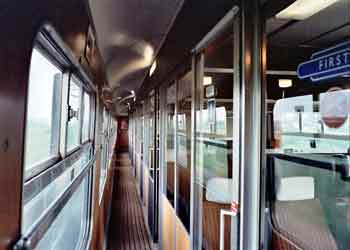 |
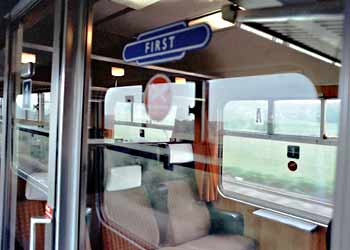 |
|
At one time the passenger accommodation on most British trains comprised compartment style seating (with side corridor walkway) such as seen here.
Compartments usually also featured passenger controlled lighting and heating controls, large picture windows and (in second and third class) four aside seating or (in first class) three aside seating which reclines, fold-up armrests and individual reading lamps. Nowadays compartments are all but extinct on British trains but are still used on some overseas railways. Clicking either the image or this link will open a page showing this and more images of passenger compartments on British trains in a popup window; |
||
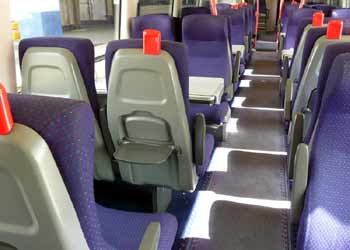 |
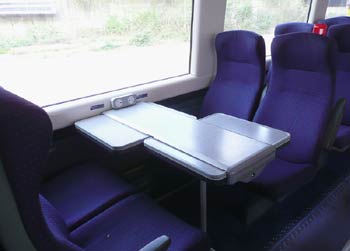 |
|
Two views from the same carriage showing 'airline' style seating with a drop-down tables on the back of the seat in front (left) and 'face to face' seating around a table (right).
Also visible are the fold-up arm rests and retractable tables which make accessing the seating easier.
From the point of view of many passengers the ideal seating arrangement for long-distance travel would be if at least half of the overall seating on the train was arranged 'face to face' around tables which are correctly aligned to clean windows. Because not all groups will contain exactly four passengers it would also be welcomed if there was some 1+3 seating and even traditional compartment-style 4+0 seating with a corridor along the carriage side. Semi-open compartments might be preferable to fully enclosed - some of the European images seen below may be seen as useful guides to alternative possibilities. The intention should be to encourage (family)(social) groups, for whom sitting together as a group around a table (or several tables) is part of what makes the journey so enjoyable. However, not all passengers want to sit at tables facing total strangers so some 'airline' seating is desirable as well - providing the seat pitch gives sufficient leg room. On some routes passengers might still have preferred a choice of compartments (perhaps marketed as travelling offices), especially for business people - such as company directors with secretaries / managers / lawyers - as the privacy they provide means their occupants can use their travelling time for business purposes, including talking on the telephone, without disturbing (or being disturbed by) other passengers. This would be particularly appreciated when confidential matters are being discussed and for which they may even wish to reserve an entire compartment. |
||
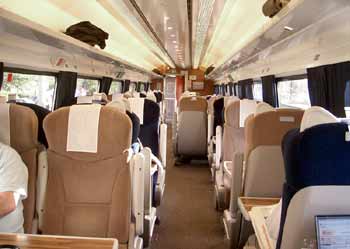 |
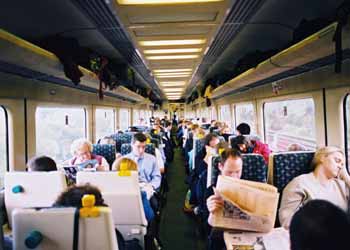 |
|
| An 'open' first class carriage with comfortable high-back 2+1 seating and slightly off-set central walkway. | 2+2 An 'open' standard class carriage on an InterCity125 train with 2+2 seating. | |
The Trains!Introduced in 1975 the diesel-powered 125mph (201km/h) HST (High Speed Train) revolutionised longer distance rail travel in Britain. Initially used on the non-electrified London (Paddington) - Bristol - South Wales / the West Country routes these trains have also seen service in many other parts of Great Britain, including on the East Coast Main Line [London (Kings Cross) - Yorkshire / Tyneside - Edinburgh - Aberdeen], Midland Main Line [London (St Pancras) - Leicester - Nottingham - Sheffield] plus various 'Cross-Country' services which link up many major British regional towns and cities but avoid London. A small fleet of HST power car derivatives (with different passenger carriages) are also used in Australia. Based in the city of Sydney they serve many destinations within New South Wales plus the neighbouring state capitals of Melbourne and Brisbane. However in Australia they are restricted to a somewhat slothful 160km/h (100mph). In 1987 the HST became the fastest diesel-powered train anywhere globally, reaching an absolute maximum speed of 148mph (238km/h). As an aside, Britain also holds the global record for the fastest steam-powered train. This was achieved in 1938 when a streamlined locomotive named Mallard achieved 126mph (202.7km/h). Despite its age the HST remains the most popular British train for long distance 'trunk' services on non-electrified routes. One reason for this is that these trains are formed of two specialist diesel engines (one at each end of the train) and a rake of unpowered Mklll passenger carriages whilst newer trains spread the diesel traction package along the train, and no matter how much the train operators downplay this passengers do notice (and dislike) the noise and vibrations from the diesel engines below them. Unlike most trains seen on this page (which are electrically powered by means of an overhead power supply system) the HST uses a traction system known as 'diesel-electric'. The liquid fuel (diesel) acts as the prime energy source but rather than directly power the train's wheels it powers an onboard electricity generating unit, with the final drive at the wheels being electric. |
||
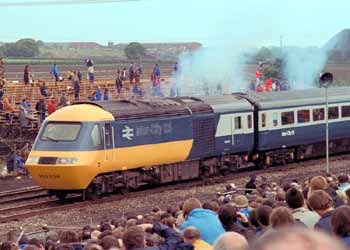 |
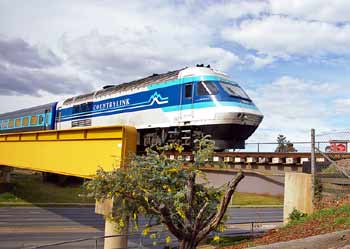 |
|
| The British High Speed Train, as seen at the 1979 Rainhill Trials event which celebrated it being 150 years since a competition to find the best locomotive for the (in 1829) new Liverpool and Manchester Railway. | CountryLink XPT 2007 (City of Albury) passes over the Tarcutta Street Overpass in Wagga Wagga. Image & license: Bidgee / Wikipedia encyclopædia. CC BY-SA 3.0 http://commons.wikimedia.org/wiki/File:CountryLink_XPT_2007.jpg. |
|
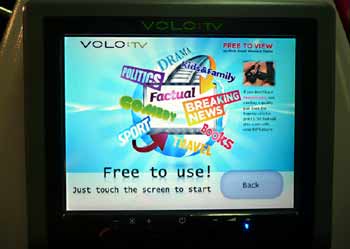 |
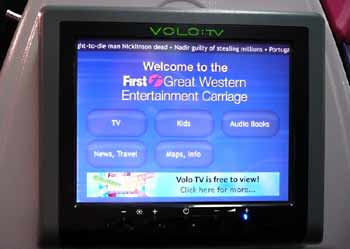 |
|
The train company First Great Western which operates trains from London's Paddington station to south Wales and south-west England has fitted an airline-style electronic information and
entertainment system to coach D of its High Speed Trains. This video-on-demand TV system is free to use, and includes comedies, drama, documentaries, children’s programmes and sports. Passengers can pause, stop, fast-forward, rewind
and re-choose any programme at their leisure. There is also a fully interactive moving map which shows real-time journey information. Passengers who do not have headphones can buy them from the buffet.
It is likely that if more passengers knew about this they would regret that the other British train operators who provide InterCity services have not equipped their trains similarly. More information can be found at these two links which open in new windows:- http://www.volo.tv/ http://www.firstgreatwestern.co.uk/Your-journey/On-board/Family-travel/Entertainment Mention should also be made of the British InterCity 225 trains which date from 1990. These also travel at 125mph but were originally intended to operate at 140mph (225km/h) - hence their name. The reason why they are restricted to 125mph is that the East Coast Main Line (which is where they operate) is not equipped for in-cab signalling which due to the impracticality of observing lineside signals at high speed is required for trains travelling at the higher speeds. These trains currently hold the British speed record for an electric train, this being 162.6mph (261.7km/h). They are formed of one class 91 electric engine, a rake of unpowered MklV passenger carriages and an unpowered 'driving van trailer' (DVT) which also has driving controls at the other end of the train. The engines always remain at one end of the train, so for half of their journeys they are pulling the train from the front and for the rest, they push the train from the back. Typically the engines will be at the northern end of the train and the DVT plus 1st class passenger carriages are at the southern end of the train. The reasons for this includes the first class accommodation being nearer the buffer stops and platform exit at London Kings Cross station. These engines are normally used with an aerodynamic raked end facing outwards and a flat 'blunt' end facing the rest of the train. The blunt end also features a drivers' cab, although when driven from here they are limited to just 110mph (177km/h). The reason for equipping the blunt end with a driver's cab is that when they were built it was intended that at night they would be detached from passenger trains and used to haul freight trains, however this rarely happened and now that the railway has been split into separate freight and passenger operating divisions with the freight people having their own dedicated engines so it is even less likely to happen. |
||
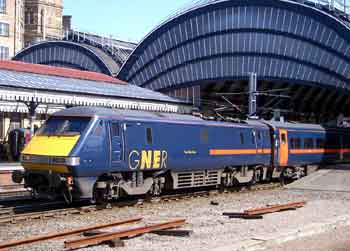 |
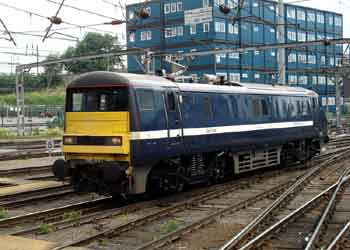 |
|
| Part of an Intercity 225 train in GNER livery. Seen at York. | It is relatively rare to see these locomotives being driven from the 'blunt' end. Seen at London Kings Cross station.
Image & license: Oxyman / Wikipedia encyclopædia. CC BY-SA 3.0 http://commons.wikimedia.org/wiki/File:91113_at_Kings_Cross_01.jpg. |
|
New, Faster, More Frequent Trains = More Passengers!In the early 2000's a new fleet of visually similar tilting and non-tilting diesel multiple unit trains were introduced to the British railway network. ('Tilting' trains are looked at further down this page). Internally the trains feature a mixture of 'at table' and 'aircraft' seats (the latter with the customary fold-down tables in the backs of the seat in front), computer power points throughout both first and standard class, an electronic seat reservation system and headphone sockets for the at-seat entertainment system. Although well known on aircraft some of these facilities had not been seen previously on a British train. Designed to reduce journey times by means of faster acceleration and a top speed of 125mph (on suitably upgraded sections of line) these trains were part of a major investment programme designed to transform under-performing services which through a lack of investment were becoming somewhat 'tired'. The ultimate aim was that over 10 years there should be a 50% increase in passenger numbers. The wider plan also included a major national marketing campaign, a new-style 'easy to understand' numbered route network with a system map and clockface timetable similar to those used on urban transport systems, and more services going to more destinations than before. Initially these trains were intended for the regional "Cross-Country" InterCity services which generally avoid London and instead use Birmingham New Street station as a hub, plus the London - North Wales service, although some now also serve other routes too. As an aside, these trains were built in several batches, but only to replace other types of train on other routes and not to strengthen the services they were originally built to operate. A significant proportion of their sphere of operations sees these trains travelling on sections of railway which benefit from having been fitted with an electric power supply, but despite the new trains also featuring an electric drive system they only power this from underfloor diesel engines which power on-board electricity generating equipment. Some passengers claim that as a result they experience much increased noise and vibration when compared with electric multiple units and the non-powered coaching stock they replaced - the new trains generally replaced traditional style locomotive hauled and HST trains. To save on brake shoe wear when slowing the train these trains use something known as 'rheostatic braking'. is system brakes the train by using the electric motors in reverse, generating electricity which is then dissipated as heat through resistors situated on the roof of each coach. By way of contrast, many electric trains return (recycle) the regenerated power back to the overhead wires for other trains to use. |
||
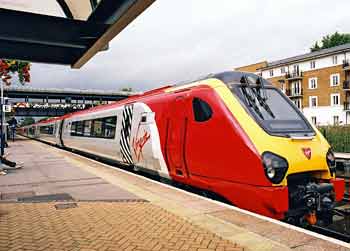 |
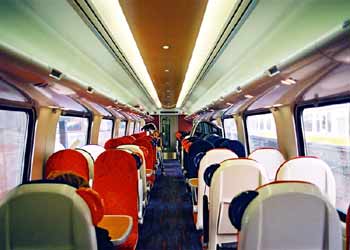 |
|
| One of the then new trains calls at London' Kensington Olympia station on a through service between Manchester and the south coast seaside resort of Brighton. | Inside a standard class carriage (in original condition) showing the mix of both 'at table' and 'aircraft' seating. On the right hand side halfway along is a luggage rack. | |
Originally these trains featured a small shop area and a buffet counter which sold light refreshments for consumption elsewhere on the train. However because the trains were so short they were frequently overcrowded and rather than add extra carriages in December 2008 the shops started being replaced with extra seating and luggage space. In future a small range of refreshments will be sold to passengers at their seats from a catering trolley. |
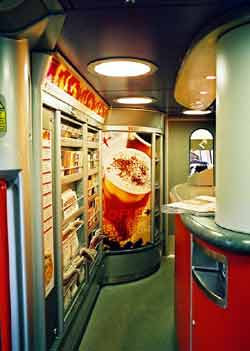
Virgin Voyager shop / buffet area as originally built. |
|
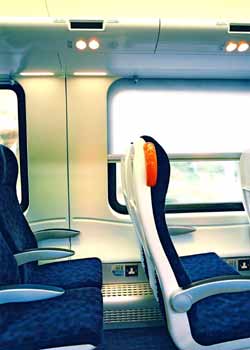 |
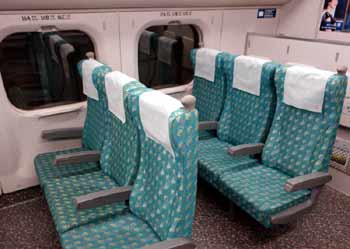 |
|
| These seating bays were carefully chosen for photography because in addition to showing the 'airline' style of seating, the reading lamps, fold-away arm rests, window blinds and (at foot level) computer / mobile telephone power sockets, this view also shows how the seats do not line up with the windows and that therefore some unfortunate passengers are not able to look outside. | This view from a high speed train in Taiwan shows that with airline style windows airline seating and windows can be aligned.
Image & license: Author Asacyan / Wikipedia encyclopædia. CC-BY-SA-3.0 http://commons.wikimedia.org/wiki/File:THSR_seat_03.JPG |
|
Err TOO MANY Passengers?! And Too Little Track CapacityBy October 2002 enough of the new trains had been delivered and brought into daily use for the timetables to be recast to take advantage of their superior performance by providing more frequent, faster services. Much to the surprise of the train operator (but not passengers) the faster, more frequent services were so popular that patronage rose 24% in the first month and 40% in the second month. So the 10 year plan was almost achieved in just 3 months! - and that was with an unpopular airline-style ticketing system which encourages advance booking & discourages passengers from just travelling 'on-spec' (ie: discourages 'turning up and travelling' - which is what people often do with a private car). Regrettably it is possible to have too much of a 'good thing'. With either just four or five carriages each, the new trains were considerably shorter than the trains they replaced and even though the plan was to counter this by operating more frequent services severe overcrowding became an issue - especially in areas where trains carry large numbers of commuters (who usually have season tickets and want to travel on specific timed trains and for whom the concept of booking in advance is simply unacceptable) and at the extremes of the network / other areas where frequencies were not increased. Right from their introduction some critics were suggesting that the trains were too short and should have been at least seven carriages long, but because of the way everything was being financed and the speculative nature of the plans it had been decided to start with short trains and then lengthen the four carriage trains to five carriages when the business case could be made and funding agreed. Furthermore it was soon found that after many decades of under-investment in the railway system and a general long term policy of closing lines / reducing capacity the infrastructure (ie: the tracks & signalling system) could not cope with the new high-frequency timetables, and with the sheer number of trains in service causing on-track congestion it was soon decided the only solution lay in reducing train frequencies. This was done in January 2003, and as anyone with even half a brain should have anticipated, only served to increase overcrowding on many of the remaining services. Nevertheless, despite these problems and the Department for Transport (who have ultimate control on routes and services on the mainline railway system) enforcing other changes to services operated by these trains - changes which critics suggest in many cases de facto make services less attractive - hindsight has shown that the 10 year plan proved widely conservative with passenger numbers nearly doubling - from 11 million to 21 million passengers per a year. It is a matter for conjecture whether this figure would have been even higher if the trains had been longer from the outset, if the railway infrastructure had been looked after properly (a comment which includes with an aim of meeting train operating requirements) and if no routes had been forcibly handed over to other train operators - some of whose trains were more suited to shorter distance suburban than regional InterCity style journeys. Apparently some critics suggested that the 10 year plan which included the introduction of these new trains was less than successful, yet it has to be asked how this can be when passenger numbers increased so significantly?. Whilst it could be argued that for long journeys passengers would prefer proper InterCity trains with traction units confined to the train 'ends' (ie: like the venerable HST) rather than under each carriage they still prove to be reasonably popular (especially to passengers who are used to the noise and vibration of travelling in motor cars and motor buses) and more trains of this design have been built for other services elsewhere in Britain. What has been proved beyond any shadow of doubt is that even when many aspects of the 'package' are less than totally optimal the British people still remain very favourably disposed to long distance rail travel - albeit only where the choice still exists / lines remain extant. New InterCity Trains: The Intercity Express ProgrammeStarting in 2017 new InterCity trains are planned to replace the diesel InterCity 125 High Speed Trains which use both the Great Western Main Line (GWML) out of London Paddington station and the East Coast Main Line (ECML) out of London Kings Cross station, and the electric InterCity 225 trains which only use the ECML. Rather than use trains of a brand new design which were created here in the UK, the Department Of Transport chose to use trains of a design that already existed, this being the Japanese Hitachi Super Express which are part of the Hitachi A-Train family. Other trains used (or planned to be used) here in the UK which are also part of the A-Train family include the Class 395 Javelin trains which are designed for speed up to 140mph (225 km/h) and the Scottish Class 485 which at the time of writing are so new that they are yet to enter service. |
||
The A-Train design concept includes several elements: the core features being that the vehicle car bodies (walls, roof, floor) are constructed from double skin aluminium extruded sections which are friction stir welded and the hollow extruded mounting rails on the vehicle body to which modular components can be attached. There will be three variants of the new trains:
|
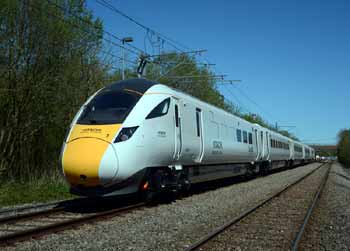
First pre-series Class 800 Hitachi InterCity Express Programme train undergoes dynamic testing Image & license: Paul Bigland / Wikipedia encyclopædia. CC BY 3.0 https://commons.wikimedia.org/wiki/File:Class_800_in_testing_2015.jpg |
|
|
Class 800 trains are "bi-mode" electro-diesel multiple units (EDMU). Where available they can be powered by AC overhead wires and at other times by underfloor diesel generators. In diesel mode they are limited to 100mph (160km/h). Their specification requires an ability to change modes when travelling at line speed. Since it is intended that at a later date the overhead wire electric power supply system will be installed along routes where Class 800 trains will initially operate in diesel mode, this batch of trains has been designed for easy conversion to pure electric Class 801 trains - a process which will include removing all but one of the diesel engines. Class 801 trains will be electric multiple unit (EMU) trains. They will only operate on electrified sections of railway, although each train will have one EDMU style diesel traction unit which will be used when shunting and as an emergency 'get me home' safety net should there be a reason why the train is not able to collect electricity from the overhead wires. Class 802 whilst also EDMU type trains these will feature higher power diesel traction units and larger fuel tanks (than Class 800 EDMUs) so that they will be better able to cope with steep gradients in Devon and Cornwall and spend more time travelling on non-electrified sections of railway. In addition to Great Western services to the West Country Class 802 trains will be used by Hull Trains - in electric mode between Kings Cross and Doncaster and diesel mode for the rest of the time. In March 2016 Virgin Trains East Coast held a high-profile launch ceremony at London Kings Cross station where Sir Richard Branson introduced the marketing name of Azuma, which is Japanese for of the east and of course also sounds somewhat similar to the English word zoom, which implies speed. InterCity East Coast franchise is operated by a partnership of Stagecoach and Virgin. The plan is for the first Azuma trains to start carrying passengers in 2018. |
||
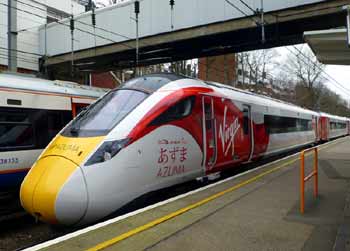 |
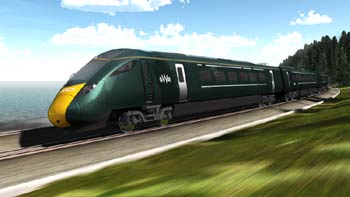 |
|
| After attending the media event the train returned to the IEP North Pole depot via the North London Line, this view shows it at Hampstead Heath station with a Class 378 London Overground train passing in the other direction. | Hitachi Super Express Train in GWR livery
Image & license: Hitachi Rail Europe / Wikipedia encyclopædia CC BY 3.0 https://commons.wikimedia.org/wiki/File:GWR_Super_Express_Train.jpg |
|
Some links to further information - all links open in new windows 
A short video showing the Class 800 101 Virgin East Coast Azuma train (plus London Overground train Class 378 233) at Hampstead Heath station has been placed on the 'youtube' film / video website and can be reached by clicking either the projector icon or this link:
http://www.youtube.com/watch?v=w9w9amWKhV4 Until November 2015 the fastest trains which operated in Britain were the French-derived Class 373 Eurostar trains which when travelling on specially constructed sections of railway were allowed to reach 186mph (300km/h). However this accolade has now been passed to the German Siemens Velaro Class 374 Eurostar trains which on suitable infrastructure (and where permitted) have a cruising speed of 320km/h (199mph). Note that these trains are not allowed to reach their top speeds on this side of the English Channel - this is because our only high speed rail line (High Speed 1 / HS1) has a 186mph speed limit. Once they have all been introduced in to service the new Class 374 trains will replace most of the original Class 373 trains and be used to expand services to new destinations, such as Amsterdam in Holland, Frankfurt and Cologne in Germany... Eurostar call their Velaro trains e320 and their older French trains e300. |
||
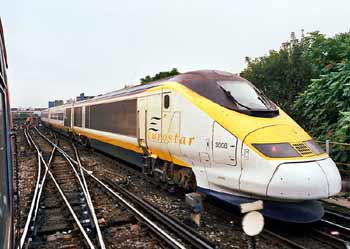 |
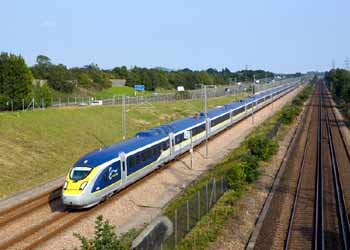 |
|
| A Class 373 Eurostar train as seen through an open window on another train shortly after both trains had departed from London Waterloo station. Note the two 3rd rail electric collection shoes hanging down from the Eurostar train's rear wheel unit. | New Eurostar Class 374 trainset on High Speed 1, near Sellindge, Kent. This photograph was taken at 400 asa with a shutter speed of 1/1250!
Image & license: David Gubler / Wikipedia encyclopædia. CC-BY-SA-4.0 http://commons.wikimedia.org/wiki/File:Eurostar_Class_374_on_HS1.jpg |
|
Most Class 373 trains were built able to operate on three different electrical power supply systems (ie: tri-voltage). These were 25kV 50 Hz AC, 3kV DC (Belgian classic lines) using pantographs collecting power from overhead wires, and 750V DC via pick-up shoes from an electrified third rail which was used British Classic lines between London Waterloo Station and the Chunnel Tunnel. The pick-up shoes were retracted when operating from overhead power. Since the opening of High Speed 1 overhead electrification has been used throughout and the third rail shoes were removed. Some of the SNCF owned trains were built able to operate on four different electrical power supply systems (ie: quadri-voltage) as to be able to serve destinations routed via the south of France they need to use French lignes classiques (ie: existing railway lines) where the overhead wires are electrified at 1,500V DC. To combat the hypnotic effect of driving through a tunnel at speed for 20 minutes, the Class 372 trains have much smaller windscreens than other high-speed trains and TGVs. |
||
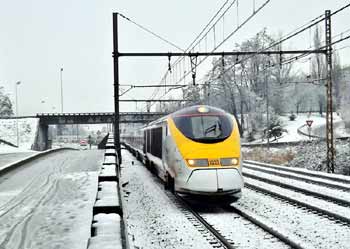 https://commons.wikimedia.org/wiki/File: Eurostar_Neige,_Chamb%C3%A9ry_(2015).JPG |
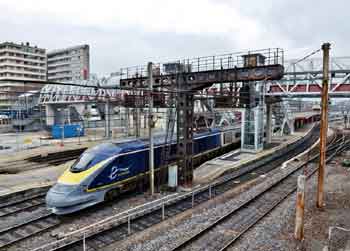 https://commons.wikimedia.org/wiki/File: Eurostar_livr%C3%A9e_bleue,_Chamb%C3%A9ry_2016.JPG |
|
| Winter Class 373 Eurostar trains travelling to Bourg-Saint-Maurice arriving at (left) and calling at (right) Chambéry station in Savoie, France. The train on the right is demonstrating the new livery which is similar to that applied to the Class 374 Eurostar trains. Both images & license: Florian Pépellin / Wikipedia encyclopædia. CC-BY-SA-3.0 |
||
Although originally intended for 'Three Capitals' services between Britain and the major cities of Paris, France and Brussels, Belgium via the Channel Tunnel Class 373 Eurostar trains have also served a few other destinations as well. These include some cities through which they pass whilst en route (eg: Lille), seasonal services direct between London and Disneyland Paris, services to winter Ski resorts, and more... They have also been used on domestic services in both the UK and France. In the UK some Class 373 Eurostar trains were used by GNER on services out of London's Kings Cross station. For these services they travelled on the existing 'classic' railway infrastructure (the East Coast Main Line) and their maximum speed was restricted to just 110mph (177km/h). GNER used some of the Eurostar trains which were built for the Regional Eurostar services which were planned to run directly from regional British cities to France and Belgium. Because of the expected lengthy journey times and rise of budget airlines whose fares were significantly cheaper than those the railway wanted to charge, these services were cancelled before they even began operating. |
||
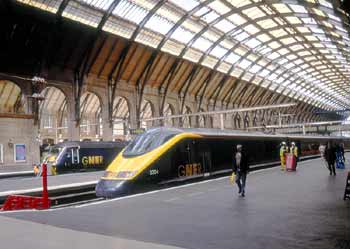 |
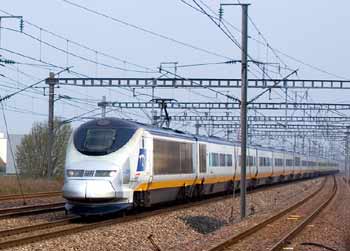 |
|
| Class 373 train (plus diesel HST) in GNER livery at London Kings Cross station. The train had recently arrived and whilst most passengers had already gone there was still a near continuous stream of stragglers, and I could not wait forever. | Class 373 in altered SNCF TGV livery (without the yellow front) on a French domestic service.
Image & license: Alf van Beem / Wikipedia encyclopædia. CC0 (public domain) https://commons.wikimedia.org/wiki/File:SNCF_TGV_3302.jpg |
|
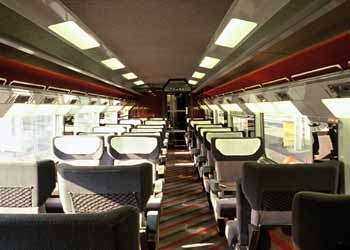 |
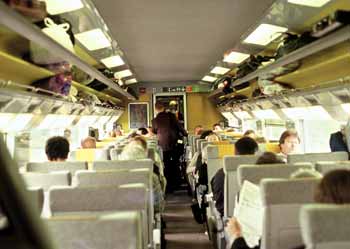 |
|
Inside a Class 373 Eurostar train operating the 'White Rose' service between London Kings Cross and York.
First class is seen on the left and Standard class on the right. Note how these trains include some at-table seating even in carriages with predominately aircraft seats; this is so that everyone will be seated facing 'inwards' - otherwise some seats would face the carriage end walls. Many people say that these trains are the most comfortable and offer the best ride quality of any train currently in use in Britain. Both types of Eurostar train are European trains for which the route to London is like a branch line. Their European variants are looked at in the European Trains section below. Examples From OverseasThe rest of this section looks at examples from overseas. In part the idea is to provide a brief overview of overseas high speed long distance rail systems, but also to show ideas as to how our railways could be improved by copying solutions used overseas - such as the children's play areas and folding tables. Apart from the comment immediately below one topic not broached on this page is fares. In some countries it is normal for the highest speed / most luxurious trains to be more expensive to travel on. Sometimes this is by means of a different fare scale, other times by means of an extra charge (supplement). When looking at how railway operators around our planet are introducing high speed services it might be worth bearing in mind that although high speeds are felt desirable as ways of shrinking journey times and providing environmentally sounder alternatives to road & air travel there is also an aspect of inter-nation (which is evolving into inter-continent - mainland Europe / Asia) rivalry in seeing whose railways can be the fastest... Of course we in Britain are totally above such rivalries and apart from one relatively small section of new-build railway - the construction of which was more about European politics than benefiting millions of British people - we (erm) 'happily' have our speedometers firmly glued at the same much heralded 'high' (sic) speed which we started using in 1975 - ie: 125mph (201km/h). Indeed, despite their much hyped higher top speed even the Japanese commuter trains which use part of the new High Speed line through Kent will not normally travel faster than 125mph! - unlike the fares, which upon their introduction rocketed skywards, even for passengers unable to use the faster trains. grr. Examples From European TrainsClass 373 Eurostar trains are one of the several variants of the French TGV (Train à Grande Vitesse) family of trains. The first TGV route linked the cities of Paris and Lyon, with public services commencing on 27th September 1981. Initially the trains travelled at speeds of up to 270km/h (168mph), with these speeds only being reached when travelling on the brand new railway infrastructure which had been specially constructed to permit such speeds. Later builds of the TGV trains and dedicated high speed infrastructure has seen the top speeds being raised to 300km/h (186mph) and (more recently) 320km/h (200mph). During their mid-life refurbishment most of the original trains were upgraded to 300km/h (186mph) capability, except for the few trains which operate on routes that only travel comparatively short distances on the dedicated high speed lines - such as those on services to Switzerland via Dijon - these still retain their original top speed of 270km/h (168mph). This is because the French National Railways (SNCF) did not consider it financially worthwhile to upgrade their maximum speed for a marginal reduction in journey time. Including the Eurostar trains there are seven types and derivatives of the TGV train, including TGV Duplex which are double deck, the 'Thalys' PBA and PBKA trains (Paris, Brussels, [Köln - Cologne], Amsterdam) and TGV Postaux, which are used by the French post office. Plus there are the TGV-K, which are used in (South) Korea. In the 1990's one TGV train was modified to become a TGV Pendulaire (ie: tilting). The idea was to further reduce journey times on routes where the TGV trains travelled over historic 'classic' tracks which featured many curves. This would be achieved because tilting trains (as detailed further down this page) are able to travel through curved sections of track at higher speeds. The experiment was a technical success, however it was decided that the cost of modifying the existing trains would be too high and with the project then being cancelled the experimental train was converted back to its original form. The specially built tracks used by TGV and other high speed trains on which they attain their highest speeds are known (in French) as LGV - Ligne à grande vitesse, which can be translated as 'high speed line'. Originally a LGV were defined as a line which permitted speeds greater than 200km/h (124mph); this guideline was subsequently revised to 250km/h (155mph) whilst the newest French LGV have been designed to permit speeds of up to 320km/h (199mph). |
||
 |
 |
|
| The French TGV (Train à Grande Vitesse) regularly operates at up to 320km/h (199mph) over a network of specially constructed dedicated rail lines. Services also run beyond the extent of the dedicated tracks, with trains operating at slower speeds. This image shows a TGV in Neuchâtel, Switzerland whilst on an international working. | "Le Bar" buffet on the single deck TGV train seen in the image on the left. On-train refreshment facilities are looked at on the page which includes On-train Refreshment Facilities. |
|
 |
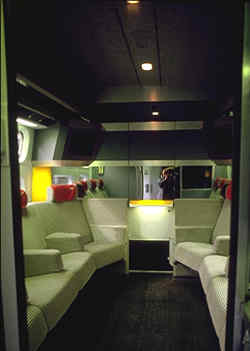 |
|
| These international TGV trains are very well equipped; this is standard class and in addition to the foot-rests (X), lift up arm-rests, litter bins (Y), window blinds (seen lowered a couple of inches) (Z), and airline-style folding seat back tables, they also feature individual reading lamps and real curtains! | Seen on a different TGV train was this private first class lounge area which was located behind the driver's cab.
These TGV images date from the days before passengers used computers and smartphones; this explains why the trains did not have power and USB sockets. |
|
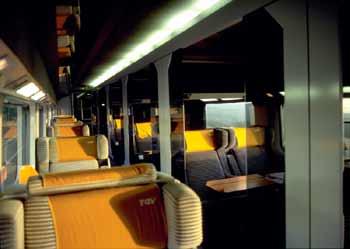 |
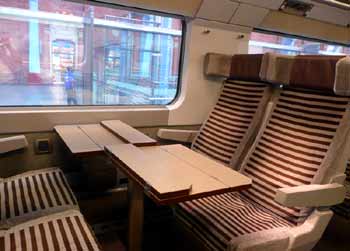 |
|
| First class ‘semi-open’ 2+2 compartments alongside 1+1 open seating on a TGV train. | A nice touch are the fold-up table flaps which make it easier to 'get into' the seats. This example was seen on a TGV-derived Eurostar train. | |
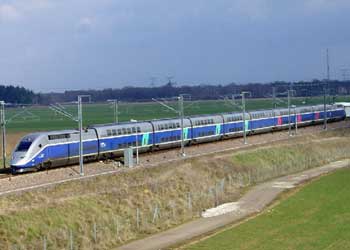 |
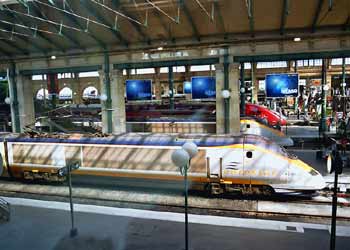 |
|
| Such is the success of the TGV that to cope with passenger numbers (on some routes) the French use double-deck (bi-level) TGV trains.
Image: http://lgv2030.free.fr/spots/s_cossigny.htm. |
Eurostar and (in the background) maroon and grey liveried Paris-Brussels-Köln-Amsterdam (PBKA) "Thalys" trains at Paris Gare Du Nord station. Photographed through a glass screen, apologies for the reflections. |
|
The success of the TGV is such that over 250,000 passengers a day travel on what is now a fleet of (approximately) 460 TGV trains and their derivatives. On 28th November 2003 SNCF celebrated carrying their billionth TGV passenger since services first began back in 1981. Despite the high speed this has been achieved with a remarkable safety record with there having been just a handful of minor mishaps. In part their safety record is attributed to the TGV family of trains being articulated. Articulated suspension has the effect of 'hinging' the carriages to each other, giving greater stability at high speed. In the rare occurrence of a derailment the trains tend to remain in a straight line and upright. These benefits were also found with the British Advanced Passenger Train (APT) in a derailment in April 1980. |
||
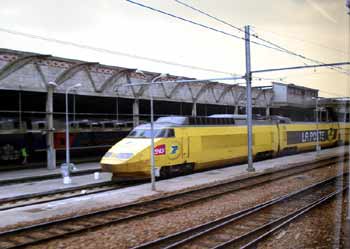 |
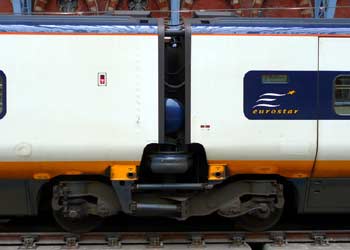 |
|
| TGV Postal (with a TGV Duplex in the background) near Paris Gare de Lyon Station Paris. Image & license: Bras Cyril / Wikipedia encyclopædia. CC BY-SA 3.0 http://commons.wikimedia.org/wiki/File:Tgv_postal_mai_2007.JPG. |
The TGV family of trains are articulated, as described above. | |
|
On many routes the introduction of the TGV has led to significant reductions in numbers of passengers travelling by air - for instance: on the Paris / Lyon route, where TGV Duplex (double deck) trains run at 30 minute intervals). Fewer short-haul flights actually benefits air travellers because it frees up airport capacity for longer distance trans-continental flights. There is much sentiment here in Britain that this represents the type of national transport policy which we should have emulated 'years ago', perhaps even as an alternative solution to increasing overall capacity at our airports. In April 2007 a TGV train created a new high speed record for a train on conventional rails, reaching 574.8km/h (357mph) and significantly overtaking the previous TGV speed record of 515km/h (320mph), which had been set in 1990. The new record was set on a recently built route between Paris and the eastern city of Strasbourg where regular services see TGV trains cruising at the slightly higher regular speed of 320km/h (almost 200mph). The train used for this speed attempt had been specially modified, with larger wheels on the two power carriages and just three intermediate (double deck) carriages. In addition, to help with the record speed attempt the overhead electric power supply had been specially uprated from the usual 25,000v ac to 31,000v ac. By way of contrast the absolute train speed record is 581km/h (361mph), this having been set by a Japanese Maglev (magnetic levitation) train in 2003. In 2008 the French unveiled the first prototype of a successor to the TGV. Known as the AGV (automotrice à grande vitesse or high-speed self-propelled carriage) the AGV replaces the dedicated power cars at the ends of the train with motors distributed on the wheelsets (bogies) under the floors of the passenger carriages. The space saved will enable the train to offer a higher seating capacity (compared to a single-deck TGV), although because the rest of the space below the carriage floors is used by the electrical control systems it will not be possible to create a Duplex (double deck) version of the AGV. The AGV's energy consumption is 20% less than TGV trains, meaning that its intended commercial speed of 360km/h (224mph) will be achieved with the same energy consumption as a TGV travelling at 300km/h. The new trains are also 10 dB quieter than TGV's (90 dB compared with 100 dB). |
||
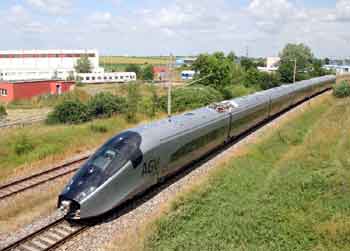 |
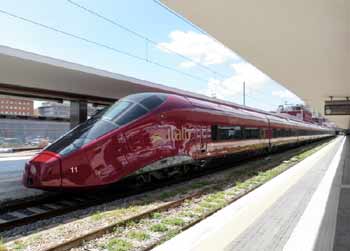 |
|
| Alstom AGV train running at 200km/h (124mph) on the Cerhenice (Velim) testing circuit, in the Czech Republic.
Image & license: Hoff1980 / Wikipedia encyclopædia. CC BY-SA 3.0 http://commons.wikimedia.org/wiki/File:Alstom_AGV_Cerhenice_img_0365.jpg |
Alstom AGV .Italo (ie: Italian version) ETR 575 in NTV red livery at Napoli Centrale (Naples Central) railway station. Image & license: Miroslav.broz / Wikipedia encyclopædia. CC BY-SA 3.0 http://commons.wikimedia.org/wiki/File:AGV_.italo_Napoli_side_view.JPG |
|
The first AGV trains to enter commercial service were introduced on a route between Naples and Milan in April 2012 by the Italian open access train operator Nuovo Trasporto Viaggiatori (NTV). So far (November 2016) this has been the only commercial exploitation of the AGV trains. In 2016 the French unveiled another batch of 320km/h TGV Duplex trains. Known as the TGV Océane these trains are used on the route between Paris and southwestern France - Bordeaux and Toulouse. The introduction of the first of the fleet into passenger service in December 2016 is six months prior to the planned summer 2017 opening of a new LGV between Tours and Bordeaux. TGV Océane trains have four wheelchair spaces, 158 first class and 398 standard class seats, these being an advertised 22% more than the TGV Atlantique fleet. First class passengers are able to rotate their seats to face the direction of travel. All passengers have access to USB and mains power ports, but in standard class there are only one each of these per pair of seats. Free wi-fi will be introduced in 2017, after installation of an optic fibre backbone and lineside 4G has been completed. Italy has what could be said to be Europe's first high-speed rail routes. These were the two ‘Direttissima’ (Italian for most direct ) lines which opened in the 1930's and achieved a very creditable - for the day - maximum speed of 180km/h (112mph). In 1978 Italy opened what is often regarded as the first ‘modern era’ high-speed rail route, the Rome - Florence Direttissima. However this Italian line was brought into use in stages - with the final section opening in 1992 - by which time the initial French TGV line had opened, and with the latter being a fully completed ‘product’ right from the start so it was the French who achieved the global accolade for ‘being first’. Initially designed for trains travelling at up to 250km/h (155mph) it is currently proposed to upgrade this line so that the maximum speed can be raised to 300km/h (186mph). This will include the installation of an ‘in-cab signalling’ system where the signal displays will be seen in the driver's cab. As with several other European countries Italy is building a network of high speed lines which serve the most trafficked routes, with slower regional trains continuing to use the existing classic lines. The Italians also have some high speed freight trains which use the high speed lines at night. The new routes are electrified at 25,000v 50 Hz AC whereas the classic lines are electrified at 3000v DC. Only trains using the higher voltage AC power supply system are allowed to travel at 300km/h. On the classic lines which use the DC power supply system the maximum permitted speed 250km/h, this is because the current drawn from the catenary at higher speeds would be too high. In Italy trains which can use both power supply systems are designated P for politensione (multi-current). Italian high speed trains use various brand names. One is Treno Alta Velocità TAV (Alta Velocità = High Speed) with the AV being displayed on the streamlined power cars / engines. Trains capable of 300km/h - 350km/h are also called Frecciarossa (Red Arrow). For many years some ‘InterCity’ trains also used the marketing name Eurostar Italia, however since 2012 most of these have been rebranded. NB: this brand name is entirely separate from the Channel Tunnel service which is also marketed as Eurostar and when it originally opened only used trains derived from the French TGV. Future plans in Italy will include the upgrade of existing 300km/h high speed lines to permit speeds of up to 360km/h (224mph). This speed can be reached by the Alstom ETR 575 trains (operated by the open access operator NTV) as detailed above and exceeded by the ETR 1000 / Frecciarossa 1000 / V300 Zefiro trains - as detailed after the next group of images. Italian Pendolino tilting trains are looked at in the tilting trains section below. |
||
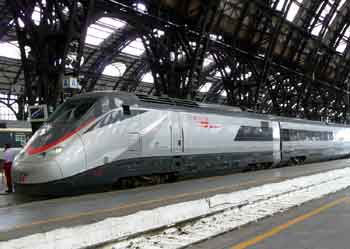 |
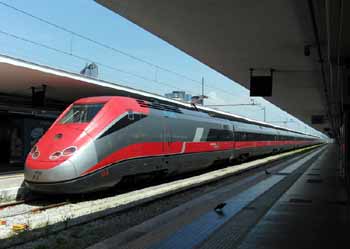 |
|
| A 300km/h (186mph) Italian ETR 500 high speed train at Milano Centrale (Milan Central) railway station. In February 2009 one of these trains set a new 'indoors' speed record while travelling through the Monte Bibele tunnel on the Bologna-Florence high speed line at 362km/h (225mph). |
ETR 500 train at Napoli Centrale (Naples Central) railway station in Frecciarossa red stripe livery.
Image & license: Mikhail (Vokabre) Shcherbakov / Wikipedia encyclopædia. CC-BY-SA-2.0 http://commons.wikimedia.org/wiki/ File:Naples,_Central_station,_gorgeous_long-distance_train.jpg |
|
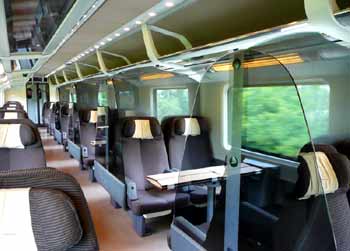 |
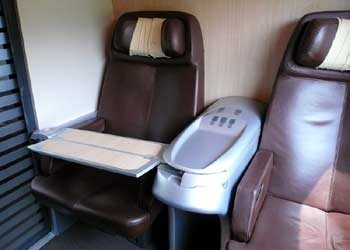 |
|
| First class ‘semi-open’ 2+2 compartments alongside 1+1 open seating. Only some seats feature the extra plastic screens. Note how the table flaps are folded closed - this helps passengers 'get into' the seating. | Inside a first class compartment showing the spacious 2+2 seating and how the folding tables are an integral part of the central binnacle. | |
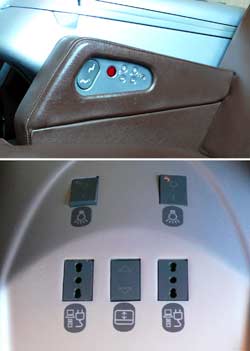 |
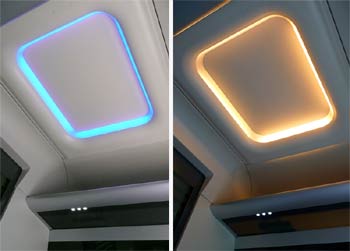 |
|
| More views from the first class compartment showing the at seat-entertainment and seat reclining controls plus the between seat binnacle which features power sockets for laptops, up / down controls for the window blind and on / off switches for the reading lamps. | In these compartments it is also possible to control the heating (not shown) and lighting, which here is seen in night (blue) and day (white) modes. The row of triple lights on the underside of the luggage rack form one seats's reading lamps. | |
Unveiled in 2013 and introduced into passenger service in 2015, the Bombardier/AnsaldoBreda joint-venture ETR 1000 / Frecciarossa 1000 / V300 Zefiro trains are intended to be capable of 400km/h (248mph), although their cruising speed is 360km/h. When first introduced they were restricted to just 300km/h, because the track infrastructure needed upgrading for this speed and the train then needed to achieve certification for the higher speed. During speed trails in November 2015 one of these trains set a new Italian rail speed record, reaching 389km/h on the Milan - Turin high-speed line. These trains are operated by Trenitalia, who are the primary Italian train operator and a subsidiary of the Italian State Railways - Ferrovie dello Stato / FS. Rather than use locomotive haulage or dedicated power motor carriages they have 16 traction motors distributed on all the bogies (wheel units) along each of the non-articulated eight carriage trains. This enhances adhesion and facilitates a high rate of acceleration. This is the first design of high-speed train to have obtained environmental impact certification (EPD). This is because it is able to contain within 28 micrograms the CO2 emissions per passenger/kilometre and for minimised noise and vibration. These trains are promoted as using construction materials that are almost 100% recyclable. Included in the train's features are numerous on-board TV style monitors in all coaches which display news and travel information that is constantly updated, power sockets at every seat, free Wi-Fi access to the onboard Internet portal and entertainment services, and a 3g Internet connection which also is configured for 4g (eventually). |
||
In all classes the seating comprises leather which has been treated with antibacterial products. These trains offer four classes of travel:
|
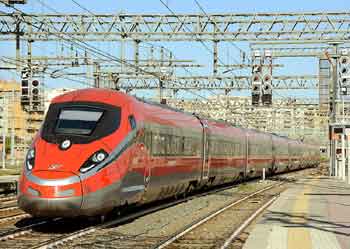 Bombardier Zefiro 300 / Italian Ferrovie dello Stato (State Railways) Frecciarossa 1000 / ETR 1000 train. Image & license: Nelso Silva / Ru Wikipedia encyclopædia. CC BY SA 2.0 https://commons.wikimedia.org/wiki/File:Elettrotreno_ETR.400.jpg |
|
|
Executive is luxury! Just 10 passengers sit in champagne coloured leather recliner style extra wide armchairs which are spread out from each other to ensure that even the tallest of passengers has ample leg room. The seating style is 1 + 1. The chairs also rotate so that passengers can always face the direction of travel. In addition there is a private room which seats five passengers which is designed for executives who wish to have a business meeting whilst travelling. Facilities in this private room include electric power sockets (for laptop computers, etc.,) and a 32-inch colour monitor which can be connected to a computer. There is a wide choice of meals and snacks which are served at seat. Before boarding the trains Executive class passengers are invited to use the special waiting rooms which are located at the main stations that are served by these trains. When the train arrives Trenitalia staff assist the passengers with boarding the train / finding their seat. Coach No.1 which has a dominant colour of brown is reserved for Executive class passengers. Business class seating is in 2 + 1 format which are spaciously spread out to ensure plenty of leg room. For added privacy there are crystal dividers. Passengers can store their luggage under the seats, on roof racks and on racks located near the train entrance doors. Coaches Nos.2 and 3 which have a dominant colour of blue are reserved for Business class passengers. Coach 2 also includes a quiet area. Only half of Coach 3 is reserved for business class passengers, and it includes special facilities for special needs passengers. This includes a large toilet cabin. Because the rest of Coach 3 is the bistro / buffet (for all passengers on the train) this too is accessible to passengers who use wheelchairs. This is claimed to be the first time that the bistro / buffet on a train of this type has been wheelchair accessible. Business class passengers are also offered a complimentary welcome drink and (on morning trains) newspaper. During the journey they are also offered a choice of sweet or savoury snacks plus a wide range of hot and cold liquid refreshments. The information does not state whether only soft drinks or also include alcohol. Passengers travelling on the non-stop Rome - Milan trains are offered a personalised box which contains special delicacies and an Illy Iperespresso coffee. Business class passengers are also able to choose from a range of multi-course meals and sandwiches which are served to them at their seat. The multi-course meals comprise Italian food products of excellence and include a main dish, a snack, a dessert and a mini bottle of water. All refreshments are served at seat. Premium class is to be found in Coach No.4 which has a red dominant colour. Here passenger accommodation comprises a more compact 2+2 seating format, but apart from that the Premium class passengers receive broadly similar benefits as Business class passengers. Standard class passengers (or 4th class, depending on your point of view) have the same seating as Premium Class passengers. About 70% of the seats are arranged in traditional style groups of four facing each other. There is space for luggage under the seats or on overhead racks. Standard Class passengers are offered a wide choice of refreshments which are served at seat. Coaches 5, 6, 7, 8 are dedicated to Standard Class passengers and the dominant colour is orange. The German high speed trains are called the ICE - InterCityExpress. They were first introduced in 1990/1, since when a family of five different types of ICE train has evolved including diesel powered and tilting versions. There is significant diversity between some of the different types of ICE train, with the first batch using power cars at both ends, the second batch having a power car at one end only and a normal unpowered carriage fitted with a driver's cab at the other end (which means that for some journeys the power car is at the front pulling the trains and for other journeys it is at the back pushing the train) and the remaining batches being of the distributed power 'multiple unit' variety. ICE2 trains are designed so that two shorter trainsets can operate as one long train for part of the route and then spilt to serve different destinations (or in reverse!) ICE 1 and ICE 2 trains have lower top speeds than many of the other European high speed trains seen on this page - when using specially built high speed infrastructure their intended top speed is 280km/h (174mph), although for a while they were restricted to 250km/h (155mph). The tilting trains are looked at further down this page. Life gets complicated for the third batch of trains, as whilst they are licensed for 330km/h (205mph) and have reached 368km/h (228.68 mph) on trial runs, in Germany they are restricted to 300km/h (186mph) - this being the maximum design speed of German high-speed lines - whilst on the newer French LGV lines they are allowed to travel at up to 320km/h (199mph). The reason for even the newest German high speed lines having a lower top speed limit than the newest French LGV lines is attributed to the decentralised nature of the German railway system where the vehicles, tracks and operations are not designed as an integrated whole. Unlike the later versions ICE 1 trains offer both compartments and open seating configurations. One of the compartments was kitted out as a dedicated conference compartment which was equipped with a large table, four freely movable chairs, an electronic typewriter, a fax machine, a telephone and mains power sockets. To use this compartment at least three seats had to be reserved and first class tickets were necessary - although after a while the 'first class tickets' rule was rescinded. When there were no reservations the conference compartment could be used by other passengers at the discretion of the trains' head conductor. When first introduced ICE 1 trains featured at-seat audio which used standard 3.5mm audio jacks and eight audio channels which were sourced from onboard compact discs (CD), broadcast radio and the two video channels. In addition, some seats featured video monitors in the backrests (for both first and standard class passengers). Furthermore every seat had its own reading lamp and there were computerised information monitors in the entrance areas which displayed information about the journey (the route, the next station, the speed, etc) and information which passengers could choose to see by using the nearby keypad. Because they were conceived in the 1980s the trains did not provide at-seat laptop power sockets and whilst there were some power sockets dotted around the train they were intended for the train cleaners and were usually disabled during the journey. In 2005 these trains were refurbished, at which time the following were removed: the audio / video systems; the public telephone booths; the foot-rests in second class; the computer terminals for timetable information and the buttons in first class that were used to call the conductor. To mitigate overcrowding and increase the capacity of the trains the second class seating pitch was reduced and an extra 60 seats added per train. As the window arrangement was not changed some passengers now have "wall window seats" ie: window seats without windows next to them. Other changes meant that the backrests in second class compartments no longer recline and those in 'open' carriages only by a limited amount. ICE trains are often to be found outside of Germany too, with the ICE 3 coming in multi-voltage versions which can also be used in France, Austria, Holland, Belgium. ICE trains also travel to Switzerland, and even provide domestic services within Switzerland. The diesel version is used on services to Denmark, and because the tax on diesel fuel used by trains is lower in Denmark (than in Germany) so it is policy to make sure that these trains have their fuel tanks filled in Denmark(!) ICE 3 trains are authorised to visit Britain too, using the Channel Tunnel and the British high speed line HS1, and although this has not yet happened there are oft-heard rumours that the Germans would like to operate through trains to London - perhaps using a different ticketing system which is less rigid and allows passengers more flexibility in times when they may travel. As an aside, it may be of comparative and regrettable interest that at the present time we do not have any home-grown British trains which we could use on through services to Germany, preferably all the way to Berlin. |
||
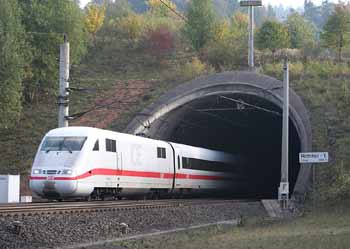 |
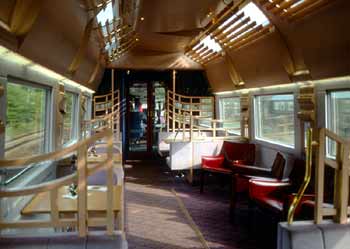 |
|
| An ICE 1 train leaves the Richthof-Tunnel of the Hannover-Würzburg high-speed railway line. Image & license: Sese Ingolstadt / Wikipedia encyclopædia. CC BY-SA 2.5 http://commons.wikimedia.org/wiki/File:Richthof_Nord.jpg |
First class lounge area on an ICE 1 train, complete with real leather armchairs! |
|
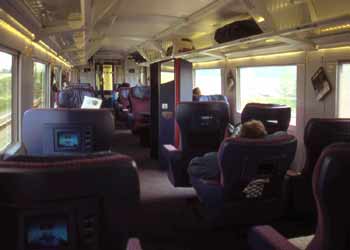 |
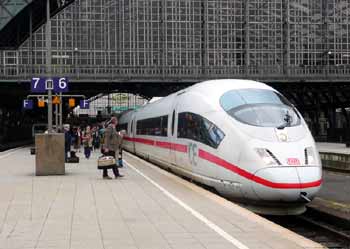 |
|
| When first built ICE 1 trains included some seats with seat-back TV displays. This was in addition to the multi-channel audio system. | An ICE 3 train arrives at one of the main Berlin stations. | |
On ICE 3, T & TD trains both first and standard class passengers can sit behind the driver and watch where the train is going - or, if at the back of the train, where it has just been!
Right: A general view looking through the glass wall between the train driver's cab and the passenger saloon. The difference on light levels means that the view through the front window is over-exposed. |
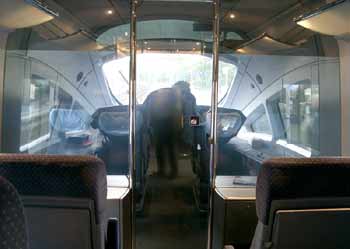 |
|
 |
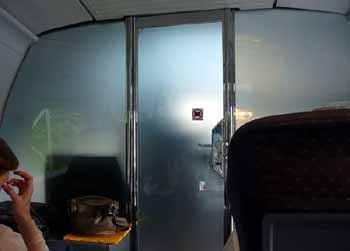 |
|
| An image which shows the forward view more clearly... with an ICE2 train approaching. Photographed when travelling at low speed. | The train driver can, at the flick of a switch, make the glass wall between the cab and passenger seating opaque. | |
 |
 |
|
Passenger information on an ICE 3 train. The red LED dot matrix screens also provide other useful information - such as present speed, next stop information and information about promotions
which the railways are offering eg: special deals on weekend breaks in London.(not illustrated)
Also not shown here are the paper leaflets which the train crew leave on seats throughout the train. These give excellent information on the individual journey, stations served, platform numbers, arrival & departure times and details of mainline & local railway (and sometimes even bus) onward connections. Of course this is how integrated transport systems *should* work - but unfortunately is the diametric opposite of how things are done in Britain, where instead all the public transports compete against each other - as well as private motoring. In 2017 the brand new ICE 4 will enter service on the Hamburg - Hannover - Nürnberg - München route. These trains have been designed for speeds of up to 250km/h whilst still having an energy consumption per seat which is 22% lower than the ICE 1 trains. A 12 carriage ICE 4 train will offer 205 first class and 625 standard class seats which have been designed for long journeys, and can be adjusted without infringing the space of the passenger behind. Other features will include: four wheelchair places, eight cycle spaces. a compartment dedicated to parents with young children, a family area, free wi-fi, LED lighting which adjusts to the time of day, and more. The ICE 4 is destined to both expand the ICE route network and replace all the ICE 1 and ICE 2 trains. Trains from the same rolling stock manufacturer / of the same type as the German ICE 3 have also been sold to the Spanish, Chinese, Russians, Dutch and Turkish for use on new high speed lines within their respective countries, plus to Eurostar for Channel Tunnel services between London, Paris, Brussels and eventually other destinations as well. The Velaro e320 Eurostar versions have a cruising speed of 320km/h (199mph) (but only when travelling on infrastructure that accepts this speed) and in Britain are known as Class 374. The Chinese version is similar to Spain's Velaro E, although it is 30cm (11.8in) wider so as to increase the number of seats by 50%. Standard class seats are arranged in a 2 + 3 layout, 1st class passengers have 2 + 2 seating and there are also 16 deluxe class seats - although only 8 of these are available to the public. In China the CRH3 variant travels at up to 350km/h (217mph) whilst the newer locally built CRH380B/BL variants are capable of cruising at 380km/h (236 mph) but were built with 420km/h (261 mph) in mind. |
||
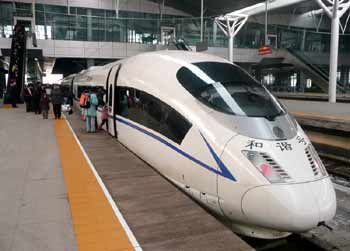 |
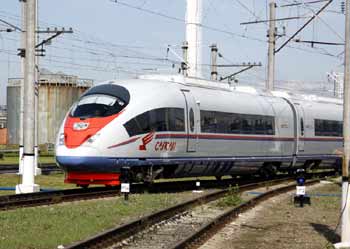 |
|
| Velaro China (Velaro CN / CRH3) at Tianjin railway station. The first 3 trains were imported from Germany, the rest were built locally. Image: Brücke-Osteuropa / Wikipedia encyclopædia. Public Domain. http://commons.wikimedia.org/wiki/File%3ACRH3_in_Tianjin.JPG |
Siemens Russian Saspan Velaro RUS.
Image & license: Black leon / Ru Wikipedia encyclopædia. CC BY-SA 3.0 http://commons.wikimedia.org/wiki/File%3ASapsan.JPG |
|
At 3,265mm (10ft 8½in) the Russian Verlaro RUS Sapsan ("Peregrine Falcon" - the fastest known bird) trains are 33cm (13in) wider than the ICE 3 version upon which they are based. Another difference is their having been specially designed to cope with Russian winters as cold as -50°C. At present they travel on the 1,520mm (4ft 11 5/6in) broad gauge classic lines, sharing the tracks with other trains. Their maximum speed is 250km/h (155mph), this is expected to rise to 330km/h (205mph) when a dedicated high speed line is built. | 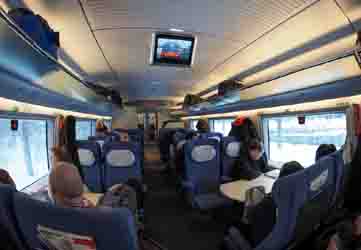 Inside a Saspan Velaro RUS train. Image & license: Sovraskin / Ru Wikipedia encyclopædia. CC BY 2.0 https://commons.wikimedia.org/wiki/File:Sapsan-vagon-russia-january-2015.jpg |
|
Saspan trains achieve a commendable occupancy rate of 84.5%, which suggests that they are liked by many Russians. However, that is not the whole story. What irks people is what was done to enable their introduction. To make space for them on congested tracks other more affordable daytime long distance and commuter trains were withdrawn, or had their timetables changed in ways which extended journey times. In addition, the extra long closure of the many level crossings along the line in advance of the passing of the faster trains (the crossings are closed 15 minutes before fast trains pass through) has been extremely unpopular with the local communities through which the railway passes. Included in the list of inconvenienced locals are bus passengers, the ambulance and fire services. Although some of the withdrawn trains were subsequently reinstated the overall feeling remains that the new service benefits the country's moneyed elite, while severely inconveniencing the majority of the population in the regions through which the railway passes. Saspan trains have also been attacked by people throwing stones at them as they pass by. In a similar way there was much dismay when the higher speed Javelin trains were introduced on classic rail lines to the south-east of London, with timetables recast and fares hiked in a deliberate attempt to force people to use the new trains. As they are medium distance commuter trains the Javelins are looked at on the Medium Distance Trains page (near the bottom). |
||
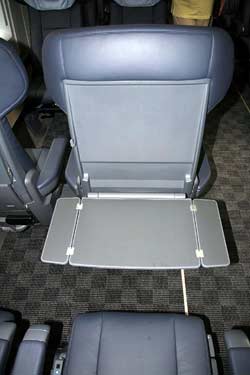 |
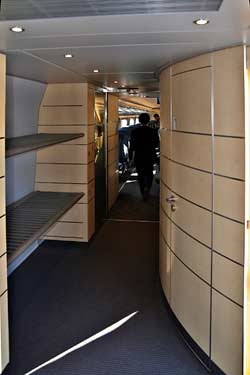 |
|
| A club class seat on the Spanish Velaro E high-speed train.
Image & license: bigbug21 / Wikipedia encyclopædia. CC BY-SA 3.0 http://commons.wikimedia.org/wiki/File%3AVelaro_e_club_seat.jpg |
Entrance area on the Spanish Velaro E high-speed train.
Image & license: Sese Ingolstadt / Wikipedia encyclopædia. CC BY-SA 3.0 http://commons.wikimedia.org/wiki/File%3AVelaro_E_Eingangsbereich.jpg |
|
|
The Spanish have also been investing very heavily in a high speed rail system, with what has become the second largest single nation network of routes (after China) linking major cities with Madrid, the capital. The Spanish trains are marketed as the AVE, which is an acronym for Alta Velocidad Española (ie: 'Spanish High Speed') with the word 'ave' also meaning 'bird' in Spanish. There are several types of AVE train, these are based on the French TGV, the Talgo VII train (see below) and the German ICE 3. Using brand new infrastructure to link Madrid with the city of Seville and travelling at speeds of up to 300km/h (186mph), the first AVE line opened on 14th April 1992. Passengers using this service benefit from a punctuality guarantee which states that if trains do not arrive within a 5 minutes of the advertised time then a full refund of the fare paid will be made. Less than 0.16% of trains arrive late enough to invoke this guarantee. However this punctuality promise is more lax on other AVE lines (eg: 15 minutes on the service to Barcelona). More recent builds of AVE train are capable of higher speeds. The AVE Class S-103 trains (which are of similar design to the German ICE 3 trains) are certified to run at 350km/h (217mph) which is the same speed as the route on which they are used (Madrid-Zaragoza-Barcelona-French border) was designed for. When this web page was first compiled the information about these trains said that rather than actually travel at 350km/h they are restricted to just 330km/h (205mph), however during the March 2016 update it was found that the trains are now restricted to 310km/h (193mph). During testing between Madrid and Zaragoza, on 16 July 2006, one of these trains reached 403.7km/h (250.8mph), in the process creating a national rail speed record for Spain. The construction of the AVE was made with international compatibility in mind, so that once tracks from the two nation's high speed networks meet (the classic lines already do meet) then high speed TGV trains from France will be able to use the Spanish system (and vice versa). To achieve this the AVE eschews the 1,668mm (5' 6") broad gauge system which predominates on the Iberian peninsular and uses standard gauge 1,435mm (4' 8½") trains. The history of 'higher' speeds within Spain goes back to the 1940's with the distinctive 'TALGO' trains that travelled on 'classic' lines. Talgo is the Spanish acronym for Tren Articulado Ligero Goicoechea Oriol (Lightweight articulated train of Goicoechea Oriol) which is so named after the train's inventor and financial partner. Talgo trains are best known for their innovative short length articulated railway passenger carriage design in which the wheels are mounted in pairs, but not joined by an axle, and between rather than underneath the individual coaches. The trains use aircraft and motor industry technologies to reduce their weight by 25% compared with 'normal' trains, plus by being as much as 1 metre lower than normal trains they feature a lower centre of gravity which meant that they are able to traverse curves at higher speeds without derailing. In the 1940's the prototype Talgo train repeatedly set new global records for train speeds. As time and technology progressed there have been several batches of Talgo train. Talgo III was introduced in 1964, and in 1968 the RD variant which was equipped with variable gauge wheelsets and variable gauge axles enabled the introduction of through trains between Madrid and Paris, as well as Barcelona to Geneva. The gauge is altered by slowly driving the train through a gauge changer or gauge changing facility. As the train passes through the wheels are unlocked, moved closer, or further apart, and re-locked. Variable gauge systems are also used in Japan and on international links between Spain/France, Finland/Sweden, Poland/Lithuania and Poland/Ukraine. The latest types of variable gauge Spanish trains use both the standard gauge high speed lines and Iberian gauge classic lines (as appropriate for their journeys) on domestic services too. These trains travel at up to 250km/h (155mph) on the high speed lines and 220km/h (137mph) on the Iberian gauge 'classic' lines. In order to extend high-quality services to parts of Spain not on the high-speed network some Talgo 250 trains are able to operate in both electric and bi-mode diesel electric modes. In electric mode they have a slightly lower top speed of 240km/h (149mph) whilst in diesel mode they have a top speed of 180km/h (111mph). Talgo 250 trains use Talgo VII tilting coaches plus two Bombardier power cars and operate the Alvia branded services. The pure electric trains are known as train type S-130 whilst the diesel electrics are train type S730. Although some Talgo trains are locomotive hauled the high speed Talgo 350 / AVE class 102 train comprises streamlined traction units at each end of the train, as well as rake of Talgo VII intermediate coaches with improved brakes and additional primary suspension and the carriage with double wheels 'inside' the train rather than at the ends. The traction units (power cars) are of a distinctive aerodynamic design which reduces noise created by air resistance at higher speeds. This design is said to resemble a duck's beak, and in Spanish these trains have been nicknamed Pato, which is Spanish for duck. |
||
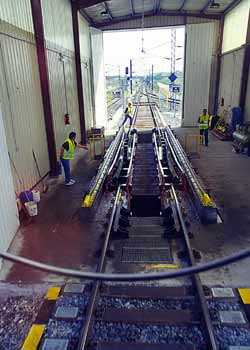 |
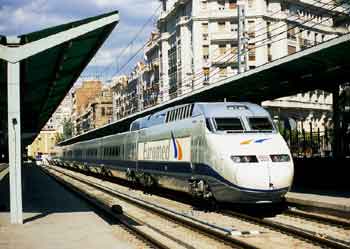 |
|
| Automatic Talgo Train gauge changing facility at Lérida.
Image & license: Falk2 / Wikipedia encyclopædia. CC BY-SA 3.0 http://commons.wikimedia.org/wiki/ File:A1-15v_Spurwechselanlage_L%C3%A9rida.jpg |
In addition to the 300km/h (186mph) standard gauge TGV derived Spanish AVE trains the Spanish Railways (RENFE) also operate some Iberian gauge (1,668mm / 5ft 6in) TGV derived trains on their 'Euromed' service. Because these trains only use classic lines
they do not travel as fast as the AVE variants, only reaching 200km/h (124mph) in normal commercial service.
Image & license: Falk2 / Wikipedia encyclopædia. CC BY-SA 3.0 http://commons.wikimedia.org/wiki/ File%3ABf_Valencia_Norte,_9_101_203a.jpg |
|
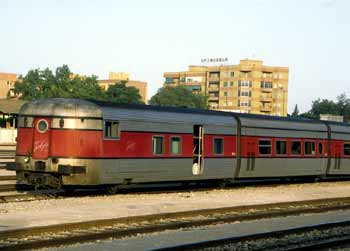 |
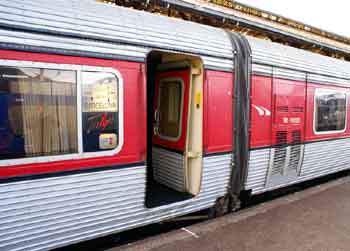 |
|
| End carriage on a Talgo III train showing the shorter carriages and single axles.
Image & license: Falk2 / Wikipedia encyclopædia. CC BY-SA 3.0 http://commons.wikimedia.org/wiki/ File:Bf_Granada,_Talgo-III-Endwagen_TG1-26.jpg |
Platform view of a Talgo III train.
Image & license: Baag / Wikipedia encyclopædia. CC BY-SA 3.0 http://commons.wikimedia.org/wiki/ File:Alter_Talgo.JPG |
|

A short video taken whilst travelling on a Talgo III train has been placed on the 'youtube' film / video website and can be reached by clicking either the projector icon or this link
http://www.youtube.com/watch?v=7dqaOfgq7L4 |
||
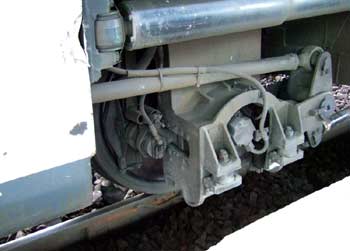 |
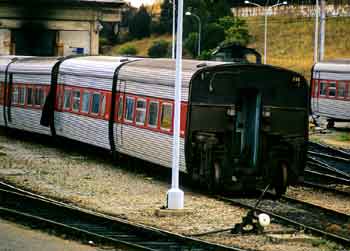 |
|
| Variable gauge axle Talgo train, with the axle at the standard gauge position. Seen in Paris, France.
Image & license: Timothy E Baldwin / Wikipedia encyclopædia. CC BY-SA 2.0 http://commons.wikimedia.org/wiki/File: Talgo_Variable_Gauge_Axle.jpg |
A Talgo III train where the connection between the carriages has been opened, showing the single singles, suspension, and more.
Image & license: Falk2 / Wikipedia encyclopædia. CC BY-SA 3.0 http://commons.wikimedia.org/wiki/File: Talgo_III,_Mittelwagen_m._Laufwerk.jpg |
|
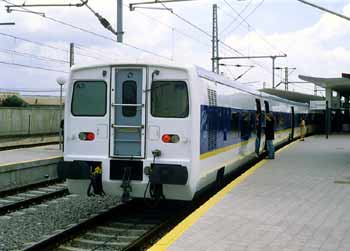 |
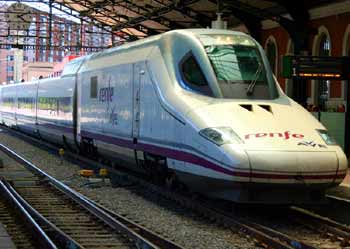 |
|
| A more modern design: A variable gauge Talgo 200 (Talgo VI) train on a Málaga-Madrid Atocha working pauses for a station stop at Córdoba.
Image & license: Falk2 / Wikipedia encyclopædia. CC BY-SA 3.0 http://commons.wikimedia.org/wiki/File: 05_063_Bf_C%C3%B3rdoba_C_(alt),_Personenendwagen_Talgo_200.jpg |
High speed Talgo 350 / AVE class 102 train AVE at Valladolid, showing the aerodynamic 'beak'. Image & license: oSiRis Naref / Wikipedia encyclopædia. CC BY-SA 2.0 http://commons.wikimedia.org/wiki/File%3AAve.jpg |
|
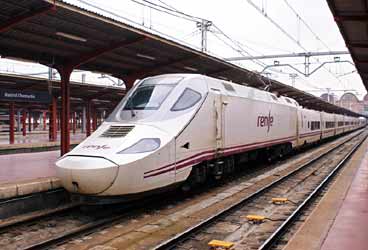 |
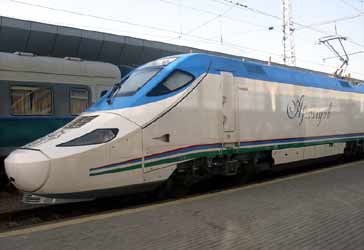 |
|
| Talgo 250 trains have been nicknamed patitos (ducklings), because of the shape of the train nose.
Image & license: Hugh Llewelyn / Wikipedia encyclopædia CC BY-SA 2.0 https://commons.wikimedia.org/wiki/File:Alvia_S-130_Talgo_(5553117352).jpg |
Talgo 250 trains are also used on the Tashkent - Samarkand high-speed rail line in Uzbekistan, where they are marketed under name of Afrosiyob. This train is at Tashkent railway station.
These 25kV AC Russian gauge trains have a top speed of 250km/h.
Image & license: Bobyrr / Wikipedia encyclopædia CC BY-SA 4.0 https://commons.wikimedia.org/wiki/File: Hi-speed_trains_Afrosiyab_(Uzbekistan)_2.JPG |
|
|
In addition to Spain and directly connected international services Talgo trains are also used in Kazakhstan, Uzbekistan, Russia and on the North American Amtrak Cascades service which travels north / south along the west coast linking the Canadian city of Vancouver with the US cities of Seattle, Portland and Eugene. As an aside, there are plans for a TGV style service all the way from San Diego as far as Seattle and probably Vancouver too. However funding this remains a stumbling block. When it opens, which will possibly be in 2016, the Saudi Arabian Haramain High Speed Rail project (which is also known as the "Western Railway" or "Makkah-Medina high speed railway") will use a fleet of Talgo 350 trains which will travel at 300km/h (186 mph). |
||
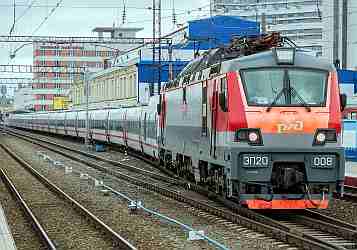 |
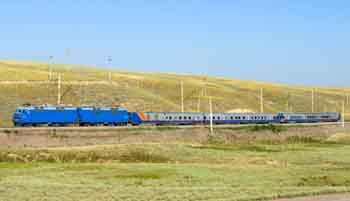 |
|
| Nizhny Novgorod - Moscow Strizh (Swift) Talgo train.
Image & license: Neu-Zwei / Wikipedia encyclopædia. CC BY-SA 4.0 https://commons.wikimedia.org/wiki/File.jpg |
Class VL80 electric locomotive and locally built Tulpar-Talgo train between Chemolgan and Zhyghyldy, as operated by Kazaqstan Temir Zholy, the national railway company of Kazakhstan. These Russian gauge trains travel at up to 200km/h. The antics of the train driver beggar belief - see below.
Image & license: David Gubler / Wikipedia encyclopædia. CC BY-SA 4.0 https://commons.wikimedia.org/wiki/File:KTZ_VL80_Tschemolgan.jpg |
|
Hauled by EP20 electric locomotives, the Russian Strizh (Swift in English) trains run between Moscow and Nizhny Novgorod, calling at Dzerzhinsk, Kovrov and Vladimir. They are painted in the colours of the Russian flag, have passive tilt and travel at up to 200km/h. In 2016 some Talgo trains which feature automatic gauge-changing equipment are scheduled to enter service on the Moscow - Minsk - Warszawa - Berlin route, a journey which will take 16 hours! The antics of the train driver in the Kazakhstan image above right beggar belief. Maybe he was upset because his train was being photographed. Unfortunately in some countries railway staff seem to take pleasure in having childish "hissy fits" (angry outburst / temper tantrum) at the sight of ordinary people pointing their cameras at the trains. However it is always a case of double-standards, as railway staff rarely object when the railway company installs cameras which are pointed at the passengers. |
||
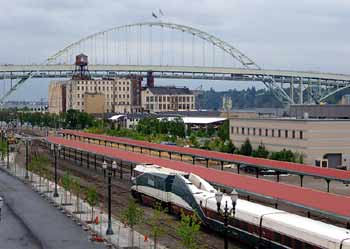 |
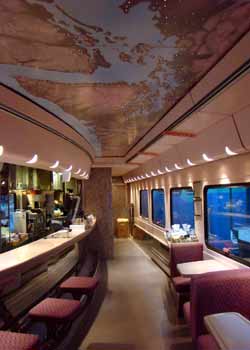 |
|
| Amtrak Cascades awaiting departure at Portland Union Station with the Fremont Bridge in the background.
Image & license: Ajbenj / Wikipedia encyclopædia. Public Domain http://commons.wikimedia.org/wiki/File%3AAmtrakcascades.jpg |
Inside an Amtrak Cascades Bistro car at night. The pin-prick sized ceiling illumination is best seen in the clickable larger image or on the Wikipedia page. Image & license: Bachcell / En Wikipedia CC BY-SA 3.0 http://commons.wikimedia.org/wiki/File%3AAmtrakCascadesDiner.JPG |
|
The Spanish also operate high speed medium distance commuter trains which have typical journey times of between 30 and 90 minutes. These travel at up to 250km (155mph) in the process showing the significantly slower British 'Javelin' train which performs a similar function towards the south-east of London a clean pair of heels. The slow-coach Javelin trains normally travel at up to 125mph (201km/h), despite being advertised as travelling at 140mph (225km/h), this being a speed they will only attain if running late when compared with the timetable. As part of the European high-speed rail network Belgium has three high speed lines which support 300km/h (186mph) operation and one that supports speeds up to 260km/h (161mph). These are used by Thalys, Eurostar, ICE and TGV services. Holland is also part of the network and their one line was also designed for trains of up to 300km/h (186mph). Belgium does not have any high speed trains of its own. The Dutch decided that rather than design and build their own high speed trains they would buy a small fleet of German ICE 3 trains which are used on a joint international service with the Germans. Both Belgium and Holland are served by international high speed services, including the Thalys, and others. |
||
Turkey has built several high speed lines, with more under construction. Built in several stages, the first three lines link Ankara (the capital city) with Istanbul and Konya. The next line will initially extend to Sivas, which is to the east of Ankara. The Spanish CAF HT65000 Series trains (which are similar to the RENFE S-120 trains) and German Siemens Valero TR trains travel at up to 250km/h (155mph) although much construction was carried out with a future speed of 350km/h in mind. Turkey has long term plans for a nationwide network of high speed lines. |
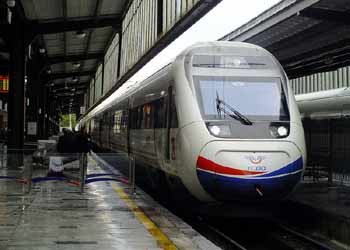 Turkish TCDD HT65000 train at Ankara Central Station. Image & license: B'Tian Denizcan P. Dorsam / Wikipedia encyclopædia. CC BY-SA 3.0 http://commons.wikimedia.org/wiki/File:YHT_at_Ankara.JPG |
|
Rather than use multiple-unit type trains, the Austrians decided to buy a dedicated fleet of unpowered passenger carriages and operate them in push-pull mode using its existing fleet of Class 1116 (Taurus) high-speed Siemens EuroSprinter electric locomotives. The passenger carriages are permanently coupled with airtight interconnections and the driving trailer at the far end of the train features a sloped end shape to match that of the Taurus locomotives. Known as Railjet these trains travel at speeds of up to 230km/h (143 mph) with some services extending into Switzerland, Germany and Hungary. |
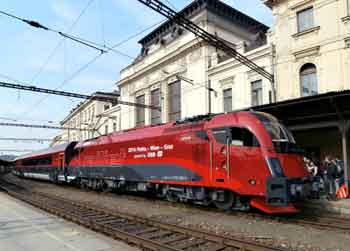 Austrian Federal Railways (Österreichische Bundesbahnen - ÖBB) Railjet train at Brno in the Czech Republic. Image & license: Miropiro / Wikipedia encyclopædia. CC BY-SA 3.0 http://commons.wikimedia.org/wiki/ File:Railjet_na_n%C3%A1dra%C5%BE%C3%AD_v_Brn%C4%9B_-_zpredu.JPG |
|
Other Longer-Distance Trains |
||
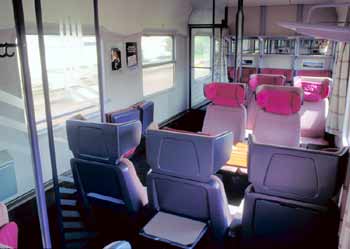 |
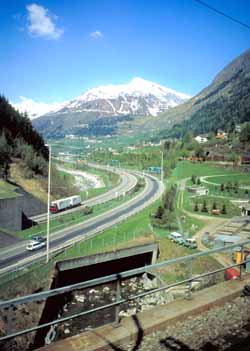 |
|
| Also in Germany (on the 'Inter-Regio' train) are these modern-style variants on the traditional compartment. There are several of these semi-open large compartments per carriage, with passengers having individual reading lamps as well as seat back tables (where appropriate). This is first class, standard class is identical in seating layout but features a different colour scheme. | Travelling in a Swiss railways observation coach - what a view... the bright sunshine and blue skies show the snow capped mountain peak to perfection. | |
Switzerland is renown for its beautiful scenery and what better way to see it than by travelling in an observation coach? Apart from special trains aimed at the leisure industry a handful of 'ordinary' trains also include these special carriages - albeit for first class passengers only. The views are spectacular - even with a motorway in the view - and better still without! These Swiss trains operate at 'normal' speeds but are featured here because (as with the German 'Inter-Regio' train also seen here) they offer the travelling public some distinctive features which could be worthy of note. |
||
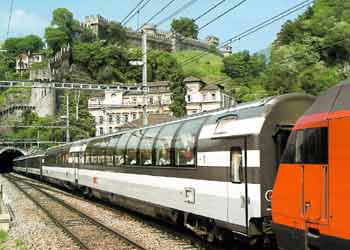 |
 |
|
| Some observation carriages behind the engine on a Swiss train. Image: Railway publicity leaflet. |
Passengers travelling in the observation carriage sit "high up" within it - although not easily seen in this view the floor slopes down towards the internal end door. Naturally the carriage is air-conditioned, but to reduce the intensity of the sunlight on really bright sunny days passengers can also lower internal window blinds. | |
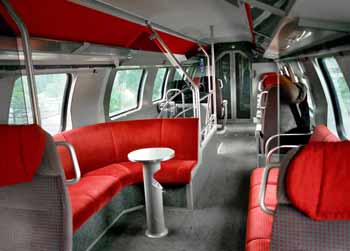 |
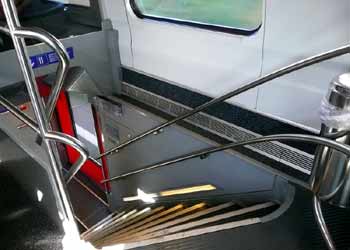 |
|
| A convivial social area on the upper floor of a Swiss double-deck (bi-level) InterCity train. There are two of these per carriage. Behind the curved part of the seat on the left is the top of a stairway. | A stairway and the inside of a carriage door. The features seen in these two images can be found in the seating areas dedicated to both first and standard class passengers. |
|
| Double deck (bi-level) trains are looked at in greater detail on the On-train Refreshment Facilities, Double-Deck Trains, & Taking Bicycles On Trains page. To help keep the youngsters occupied and happy on long journeys the standard class accommodation on some European trains includes dedicated 'family coaches' complete with a play area for young children. The examples shown here come from Switzerland, the railways in a few other countries also offer children's play areas. Single deck trains in Switzerland only feature table tops which have been printed with board game designs, passengers can either supply their own board game pieces or buy them from the restaurant / bistro / minibar. By way of contrast, the Swiss IC2000 double deck trains also offer active play areas with slides, climbing frames, bridges, boats, caves, and more. The play area is upstairs and space for pushchairs / buggies / strollers (and bicycles) is downstairs. |
||
 |
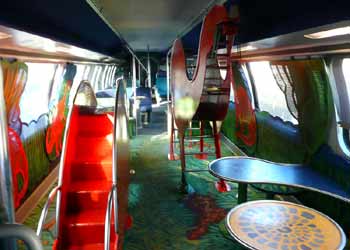 |
|
| There are several themes to the Swiss train play areas - this one is dinosaurs. | ||
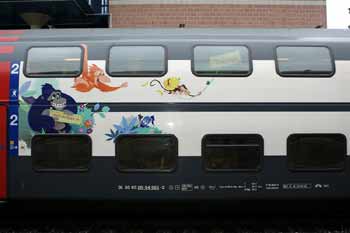
Image & license: Markus Giger / Wikipedia encyclopædia. CC BY SA 2.5 CH commons.wikimedia.org/wiki/File:Familienwagen_IC_2000_Bt5085_26-94_925-2_April2013.jpg |
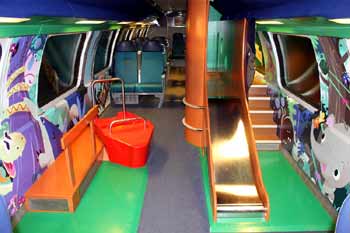
Image & license: NAC / Wikipedia encyclopædia. CC-BY-SA-4.0 https://commons.wikimedia.org/wiki/ File:FFS_Bt_50_85_26-94_900-5_interno_230413.jpg |
|
Swiss train play area based upon a jungle book theme.
| ||
Switzerland does not have any high-speed trains of its own, although it is served by those of other nations. However these only travel at normal speeds. Instead the Swiss have opted to reduce journey times by upgrading existing classic lines, using tilting trains and bulding new routes through the mountains so the trains do not need to negotiate steep inclines. Base TunnelsIn Switzerland the 'big ticket' investments are being made in the building of 'base' level tunnels under the Alps (plus in some cases new open air lines which feed into the tunnels) which avoid the need for trains to climb one side and descend the other side. These are mostly single bore twin tunnels approximately 40 metres apart with cross passages approximately every 300 metres. In a project called AlpTransit (and sometimes also as New Railway Link through the Alps) the genesis of the base tunnels was a desire to reduce road traffic by allowing heavy freight trains (some of which will carry HGV's) to link northern Europe and Italy without congesting existing roads or building new roads. Its not just that the roads were seen as unsightly but also because of the noise, air pollution (diesel road traffic!) and that the Swiss just did not want to be overrun by through traffic. In addition, to ensure that HGV's contribute financially towards the cost of building and maintaining the roads they use when travelling through Switzerland road tolls were introduced. This was done after it was realised that HGV's have large enough fuel tanks to travel all the way through Switzerland without even needing to by fuel (diesel), which means that they were not contributing towards the cost of the roads they were using. There are four* planned base tunnels which serve two different routes. Three of the base tunnels will be on the Gotthard axis. The main tunnel is the 57 km (35 miles) Gotthard Base Tunnel which opened in summer 2016. This is the longest rail tunnel anywhere planetwide. It largely replaces the Gotthard Bahn which a winding mountain railway that opened in 1882 and was operating at capacity. The old rail route is still being retained to serve local communities and for the leisure market for which journey times (durations) are rarely an issue and the many splendid views of the mountains represents an attraction. Timetabled services began using this base tunnel at the time of the annual timetable changes in December 2016. There are 50 passenger trains a day, with journeys through the tuunnel taking about 20 minutes - which is about 30 minutes faster than going via the old route. Although designed for trains travelling at up to 250km/h, initial passenger services are restricted to just 200km/h. Freight services also benefit, with the number of paths rising from 180 to 210 trains per day. To the south of Switzerland (in Canton Ticino) will be the 15.4 km (9.6 miles) Ceneri Base Tunnel. Final breakthrough in digging the twin tunnels was in January 2016 and the first trains are expected to start using them in 2020. Once it has opened high speed passenger trains with a top speed of 250 km/h (155 mph) will reduce travel time between Zürich and Milan from the current 4 hours to 2 hours 30 minutes. In addition to long distance trains, this tunnel will also benefit local passengers with journeys on the S-Bahn from Locarno to Lugano taking 22 minutes - instead of the present-day 50 - 55 minutes. Journey times between Bellinzona and Lugano will also be reduced. For freight trains the opening of this base tunnel is expected to see the number of available paths increasing from 210 to 260 per day. The plans for the Zimmerberg Base Tunnel was for it to be built as two sections however whilst part one (which passes below the city of Zürich) has been built, financial constraints have caused construction of part two to be postponed until works commence on phase two of the AlpTransit project. *Although not on a route used by heavy freight trains regional politics within Switzerland might also see phase two including the construction of a fifth tunnel, this being the Hirzel rail tunnel.The other AlpTransit route partially opened in 2007. This is the 34.6km (21.5 mile) Lötschberg Base Tunnels. This tunnel is used by trains on the western transit link via Basel - Olten - Bern - Brig - Domodossola - Milan. It is also being used by high speed passenger trains travelling at up to 250km/h (155mph). However to save money only one of the twin tunnels is fully open; a third of the other tunnel remains to be dug, another third has been dug but needs fitting out whilst the final third s also open. Austria and Italy are also building an Alpine base tunnel. This is below the Brenner Pass and is part of an EU inspired project to create a heavy freight corridor from Berlin (Germany) to Palermo (Italy). The tunnel consists of three bores. First is the test bore, this will help the tunnellers determine the geology being passed through and decide upon the best methods of tunnelling the two single-track main bores which are located above (and either side of) the test bore. At 55km (34 miles) the Brenner Base Tunnel will be only slightly shorter than the Gotthard Base Tunnel. The diameter of the single track tubes is 8.1m (27ft) The Brenner Base Tunnel is expected to open in circa 2025, when it does the operating speed will be 250km/h (155mph) for passenger trains and 160km/h (99mph) for freight trains. The planned new 270km (170 miles) long Turin - Lyon high(ish) speed railway will also include a 57km (35 miles) base tunnel base tunnel. Although (by present-day standards) only a medium speed line this railway will link the French and Italian high-speed rail networks. and allow heavy freight trains to transit at 100 km/h (62mph) and passenger trains at up to 220 km/h (140 mph). This line is very contentious with opponents claiming that whilst slow and circuitous the existing railway route does not carry sufficient traffic justify the new line. However reasons for the low use of the existing line include it having an unusually low maximum allowable train height and such steep gradients and sharp curves in its high valley sections that journey speeds are severely restricted. If the base tunnel is built the travel time between Milan and Paris will reduce from seven hours to four hours, and depending on place of origin plus ultimate destination the journey time reductions could even make the new line competitive with air travel. Examples From Beyond EuropeOutside of Europe high speed trains operate in just a handful of countries - these being the USA, Japan, (South) Korea, Taiwan and China. Although Australia uses some trains which are based on the British HST they travel at considerably lower speeds which cannot be classified as "high". Today the fastest passenger trains travel at 160km/h (100mph), which was first achieved in the early 1980s. The current Australian railway speed record is 210km/h (130mph). This was created in 1999 and was set by a 1067mm (3' 6") gauge Queensland Railways electric tilting train. However this speed is more of a reflection of the fastest that the train was allowed to travel rather than the absolute fastest it would be capable of reaching. Over the years there have been several proposals for 'something' high speed (possibly upgraded conventional railway using tilting trains, a TGV style train using specially built infrastructure or a magnetic levitation train) to link Melbourne with Canberra and Sydney, however so far they have always floundered. In December 2008 the Australian Government announced that a Very Fast Train was the government's highest infrastructure priority, but until construction actually begins it remains to be seen if this will come into fruition. One would have thought that North America would be the host of many high speed railway services, however whilst at one time the US was amongst the leaders in global passenger rail technologies the distances are so great that the rise of the aviation industry resulted in a very steep decline in passenger rail travel ('transportation' in 'American' English). However there are some transit corridors where journey times are such that passenger rail travel can retain a competitive edge over air travel, and it is in these that investments have been focussed. As North America's fastest trains are also tilting trains they are looked at in the section below which looks at tilting trains. Japan's Shinkansen high speed trains are legendary. Their punctuality puts most other railway systems to shame. Partly this will be because the Japanese know that it is often cheaper to spend a little more money with the initial investment and use better quality components (eg: heavier duty track [rails]) as well as a certain amount of duplication so that if a component does give trouble its duties can be carried out by other components also on the train. Many Japanese railways are not profitable at the farebox but through clever marketing and things such as income from real estate (eg: shopping centres at stations) the overall businesses are able to maintain their financial integrity. The word Shinkansen literally means new trunk line, referring to the tracks, but the name is widely used inside and outside Japan to refer to the trains as well as the system as a whole. Shinkansen trains are also sometimes known as Bullet Train. The network dates from the Tokaido Shinkansen of 1964, nowadays train speeds vary between 240 - 320 km/h (149 - 200 mph) depending on the route. The Tokaido Shinkansen is the busiest service, linking Tokyo and Osaka, the two largest metropolises in Japan. At the busiest times there are 13 trains per hour, per direction, with a minimum headway of three minutes between each train. The trains consist of 16 carriages which provide 1,323 seats. Such are the numbers of people travelling that some Japanese commuter routes are served by double deck (bi-level) Shinkansen trains, which even with very high density 3+3 seating still often run at 200% capacity! (ie: as many passengers standing as sitting). Japan has many different types of Bullet (Shinkansen) trains, there is of course no need to show more than a few of them... |
||
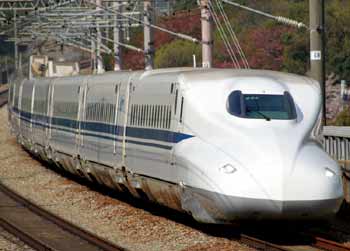 |
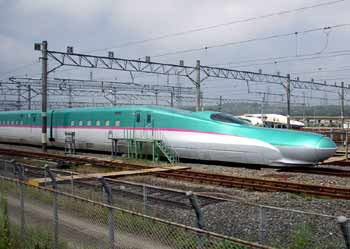 |
|
| The 300km/h (186mph) N700 Shinkansen Super-express EMU accelerates at 2.6km/h/s and reaches over 270km/h (168mph) in less than 3 minutes. It also tilts by 1 degree on curves as this allows the trains to maintain 270km/h even on 2,500metre
radius curves that previously had a maximum speed of 255km/h (158mph).
Image & license: Mitsuki-2368 / Wikipedia encyclopædia. CC BY-SA 3.0 http://commons.wikimedia.org/wiki/File:JRC_N700_series_Z28.jpg |
E5 series pre-production Shinkansen set S11 at Sendai General Shinkansen Depot, 25 July 2009. In February 2013 this was upgraded to full-production standard and renumbered U1, although it retains the flush plug doors for the passenger doors
immediately behind the driving cabs, whereas the full-production sets have recessed sliding doors. These trains operate the 320km/h (199mph) Hayabusa service.
Image & license: DAJF / Wikipedia encyclopædia. CC BY-SA 3.0 http://commons.wikimedia.org/wiki/File%3AE5_S11_Sendai_20090725.JPG |
|
The Japanese Komachi service which uses E6 Shinkansen series trainsets also travels at a maximum speed of 320km/h. However only between Tokyo Station and Morioka, during which time it is coupled to one of the Tohoku Shinkansen E5 series Hayabusa trains seen above-right. After Morioka, the Komachi service continues along standard gauge tracks that were converted from narrow gauge. Because this section of railway has level crossings its maximum speed is restricted to just 130km/h (80 mph). E6 trains feature active suspension with tilting up to 1.5 degrees. |
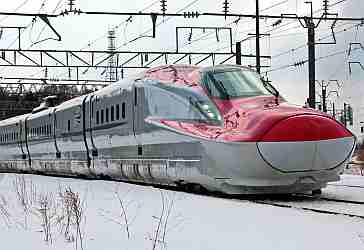
A JR East E6 series train near Akita on an Akita Shinkansen Komachi service. Image & license: Jerôme Laborde / Wikipedia encyclopædia. CC BY-SA 3.0 https://commons.wikimedia.org/wiki/File:Akita_Shinkansen_-_E6_series.jpg |
|
A Short Japanese Diversion: Worthy of note is the fleet of luxury sightseeing trains introduced in 2013 by Kintetsu, who are one of the smaller private Japanese railways. These 50000 series Shimakaze (breeze in the Shima area) trains operate ordinary schedules aimed at the general public. (Also in Japan are some luxury land-cruise hotel trains which are aimed at the super-rich; these are not looked at on this website.) The composite / twin image views were created by the person who took the photographs and published them to the Wikipedia encyclopædia. |
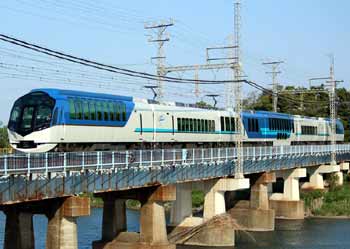
One of the luxury Shimakaze trains. Image & license: Oka21000 / Wikipedia encyclopædia. CC BY-SA 3.0 http://commons.wikimedia.org/wiki/File:KINTETSU50000_C.JPG |
|
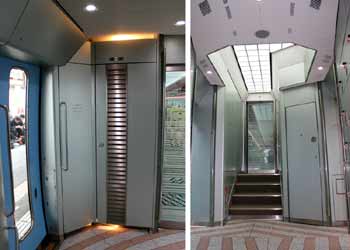 |
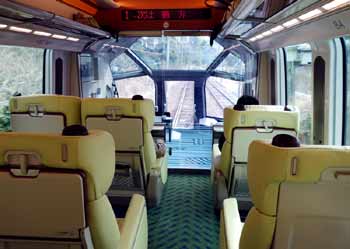 |
|
| A composite view showing one of the train entrance vestibules.
Image & license: Oka21000 / Wikipedia encyclopædia. CC BY-SA 3.0 http://commons.wikimedia.org/wiki/File:KINTETSU50000_ENTRANCE2.JPG |
These trains feature luxury leather seating similar to that which airlines offer 1st class passengers. Both end carriages offer passengers a train drivers' forward view (obviously according to direction of travel). Image & license: Asacyan / Wikipedia encyclopædia. CC BY-SA 3.0 http://commons.wikimedia.org/wiki/File:Simakaze_12.JPG |
|
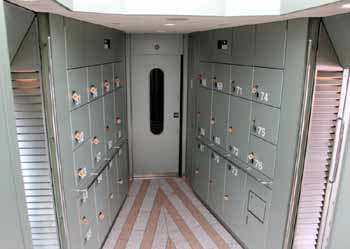 |
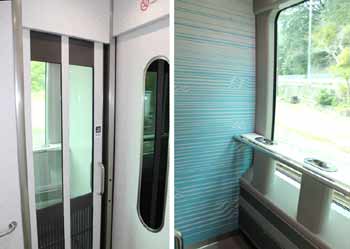 |
|
| These trains include lockers which represent an ideal solution for passengers travelling with luggage.
Image & license: Oka21000 / Wikipedia encyclopædia. CC BY-SA 3.0 http://commons.wikimedia.org/wiki/File:KINTETSU50000_LOCKER.JPG |
There is even a small smoking room.
Image & license: Oka21000 / Wikipedia encyclopædia. CC BY-SA 3.0 http://commons.wikimedia.org/wiki/File:KINTETSU50000_SMOKING_ROOM.JPG |
|
The On-train Refreshment Facilities, Double-Deck Trains, & Taking Bicycles On Trains page includes some photographs of the side-facing seating areas in the double-deck cafeteria carriage. More information about these luxurious trains can be found at these links: |
||
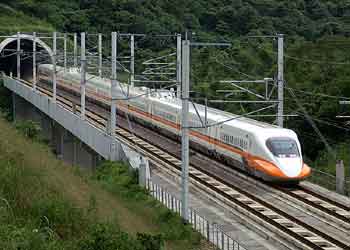 |
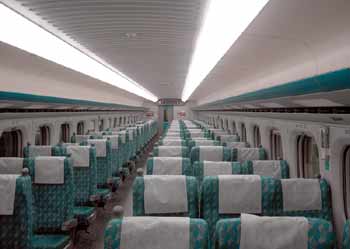 |
|
| The Taiwan High Speed Rail seen when on test and a view inside one of the trains, showing the 3+2 airline style seating in standard class. | ||
| Image & license: Encino / Wikipedia encyclopædia. Public Domain
commons.wikimedia.org/wiki/File:Taiwan-HighSpeedRail-700T-testrun-2006-0624.jpg |
Image & license: A-giâu / Wikipedia encyclopædia. CC BY-SA 3.0
http://commons.wikimedia.org/wiki/File%3ATHSR_train_17.jpg |
|
|
The (South) Korean Korea Train eXpress (KTX) links the capital Seoul to Busan. The initial KTX-I trainsets are largely based on the French TGV with 12 being built in France (where they are also known as the TGV-K) and the other 34 being built locally. They have a top speed of 350km/h (217mph), although initially in normal service they travelled at 300km/h (186mph). In November 2007 this top speed was raised to 305km/h (190mph) in response to frequent passenger complaints regarding speeds on the video display staying just below the advertised 300km/h mark. The initial system took a dozen years to build, opening at the end of March 2004, and also includes some lower speed running on existing conventional lines. The cost was much more expensive than originally estimated, soaring from an expected 5 trillion Korean Won to an actual 18 trillion Korean Won. Less than two years after the system opened the market share of rail on the Seoul-Busan corridor had increased from 38% (2003) to nearly 61% (2005), with air travel dropping from 42% to 25% and road travel falling from 20% to 14%. By 2007 the system was making good daily operating profits and had achieved financial breakeven. As part of a plan to cut journey times between major cities to just 90 minutes, Korea is continuing to expand its system and has started designing and building its own trains as well. In March 2013 trials of the type of train which later became known as HEMU-430X [High-Speed Electric Multiple Unit 430km/h (267mph) eXperimental] saw the speed of 421.4km/h being achieved, making South Korea the world's fourth country after France, Japan and China to develop a high-speed train running on conventional rails above 420km/h (261mph) The main new feature of the train compared to the previous types of Korean high-speed trains is distributed traction. The intended normal cruising speed of the production trains (which are expected to be named KTX-III) will be 370km/h (230mph). |
||
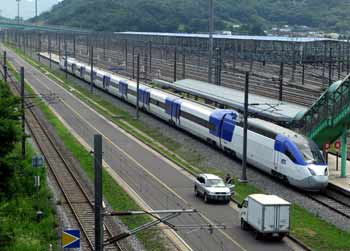 |
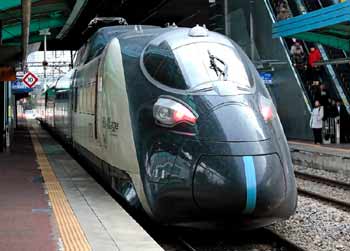 |
|
| Locally built Korean KTX-2 train.
Image & license: G43 / Wikipedia encyclopædia. CC BY-SA 3.0 http://commons.wikimedia.org/wiki/File%3AKorail_KTX-2.jpg |
HEMU-430X Test run at Seodaejeon Station.
Image & Minseong Kim / Wikipedia encyclopædia. CC BY-SA 4.0 https://commons.wikimedia.org/wiki/File:HEMU-430X_Test_run.jpg |
|
|
China's first high speed line opened in 2007 since when the network has grown rapidly. China now has the largest high speed train network of any nation, however given that this is also the largest nation (both in population and land mass) so this should be expected. To catch-up other nations with respect of railway technologies the Chinese government encouraged Chinese companies to enter into partnerships (joint ventures were prohibited) with well-established foreign railway industry companies. These agreements included a requirement that most of the trains be built within China and that through a process known as technology transfer Chinese companies would be able to learn the technologies involved. Chinese technicians involved in these projects subsequently re-designed many of the train's components so that future builds of similar trains could travel at higher speeds than the foreign designs allowed. Because of this China holds many new patents related to the internal components of these trains, although these patents are only valid within China, and as such hold no international power. Whilst the signalling, track and support structures, control software and station design have mostly been developed domestically, there has been some overseas assistance in these fields as well. Nevertheless the system as a whole is predominantly Chinese. Having mastered the relevant technologies China has started to compete with the established companies on the global stage... The Chinese CHR3 / Siemens Velaro trains are seen elsewhere on this page. The two images below show trains designed for cruising at 350km/h (217mph) and a maximum service speed of 380km/h (236mph), this being the speed the infrastructure on the routes they werve was designed for. In a December 2010 test one of the home-grown CRH380A trains reached the maximum speed of 486.1km/h (302mph) during which time it travelled 220km (137 miles) in 34 minutes, at an average speed of 388 km/h (241 mph). When in public service an automated maximum speed control system will prevent trains from reaching such high speeds. When slowing for station stops their regenerative braking system returns almost 800 kWh of electric power back to the power supply grid. |
||
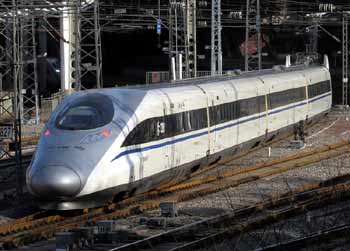 |
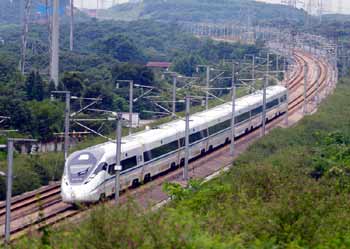 |
|
| The CRH380A was developed by CSR Corporation Limited (China South Locomotive & Rolling Stock Corporation Limited).
Image & license: N509FZ / Wikipedia encyclopædia. CC BY-SA 4.0 https://commons.wikimedia.org/wiki/File:CRH380AL-2587@BJX_(20150118145258).JPGG. |
CRH380D on the Hangzhou high-speed railway. These trains are derived from the Bombardier Zefiro family (Zefiro 380).
Image & license: Cobaltum / Wikipedia encyclopædia. CC BY-SA 4.0 https://commons.wikimedia.org/wiki/File:CRH380D%E4%BA%8E%E5% AE%81%E6%9D%AD%E9%AB%98%E9%80%9F%E9%93%81%E8%B7%AF.jpg. |
|
|
The first Argentinian high-speed rail service will link the cities of Buenos Aires, Rosario and Córdoba. To be known as Tren de Alta Velocidad (TAVe). Trains will travel at 320km/h (199mph). Unlike most other newly constructed high speed lines the Argentinian system will mostly consist of a single track, although there will be a 55km (34 mile) double-track section between Buenos Aires and Rosario which will act as a passing loop to allow trains on this section to pass one another at high speed. The trains will be variants of the double deck TGV Duplex trains already used in France. Once open the estimated Buenos Aires - Rosario journey time will be just 85 minutes (for comparison an intercity passenger bus takes about four hours) with Córdoba reached 90 minutes later. Also proposed is a second line to link Buenos Aires with the coastal resort city of Mar del Plata. At one time this was served by trains travelling at up to 150km/h (93mph), which in its era was considered to be very high speed and taking 3 hours 45 minutes to complete the approximately 400km (250 mile) journey. Nowadays trains take considerably longer than this, but with a TAVe travelling at a maximum of 320km/h (199mph) the journey should be completed in under two hours (including intermediate station stops). There have been adverse comments because of the cost of the TAVe project which is cited as being disproportionately expensive relative to the number of people who will benefit from it, and that its funding is abstracting from investment on heavily used but under-funded urban railway services in Buenos Aires. In February 2009 the entire project was placed "on hold" due to the financial crisis. The first Brazilian high-speed rail service will link Brazil's two largest cities - Rio de Janeiro and São Paulo - and then extend to Campinas. Known as The Rio - São Paulo High Speed rail (Portuguese: Trem de Alta Velocidade Rio-São Paulo; Abbreviation: TAV RJ-SP) it was hoped that at least the Campinas - Rio section would be open before Brazil hosts the 20th FIFA World Cup (soccer / football) tournament in June / July 2014, but this did not happen. Maybe it (or even the full route) will be ready in time for the 2016 Olympic Games which will be held in Rio de Janeiro. With a distance of 412km (256 miles) journeys between São Paulo and Rio de Janeiro are tentatively expected to take about 85 minutes at a maximum speed of 360km/h (224mph) with trains carrying up to 855 passengers running at 15 minute intervals. More lines are also planned, serving many other destinations elsewhere within Brazil. The High Speed DilemmaWhen considering and comparing the top speeds achieved on some railway services it is worth bearing in mind an often overlooked impediment - the atmosphere. For sure it is important that the trains and tracks are built to meet appropriate mechanical and safety standards so as to be able to cope with any stresses experienced when travelling at high speed, and of course internal ambiance / passenger comfort are very important too, but of equal importance is that the faster the train travels the greater the resistance it experiences from the air. Indeed, at some of the top speeds which trains travel the air becomes like thick treacle, and even with aerodynamic streamlining the only way that the trains manage to overcome this is through considerably increased energy consumption. What this means is that until the time comes when trains are able to create a mini-vacuum in front of them so as to minimise airborne resistance so the significantly increased energy requirements required to slice through the air will remain a constraining factor on top speeds. Tilting trainsWhy Tilt Trains?Many very high speed trains (eg: French TGV, Japanese Bullet Train etc,.) achieve their very high speeds by means of brand new specially designed dedicated tracks which, to coax the maximum performance from the trains, feature gentle gradients and curves. On 'ordinary' tracks these trains are frequently restricted to the same speeds as conventional trains. However, these new lines are expensive to construct and can only be justified on the busiest of routes. Even then, in countries such as Britain the investment has not been made (with the notable exception of the prestigious Channel Tunnel Eurostar route - aka: 'High Speed 1' - which is of next to no benefit for most British people) because of a lack of will to do so and instead the policy has been / still is to (half-heartedly) upgrade existing tracks. Meanwhile, in countries such as France and Germany, which have / are still building new lines they are now reaching a point where the most profitable / major routes are either built or soon will be; and whilst there is plenty of demand for even more new lines the routes involved will be less profitable plus increasing environmental concerns are putting up the construction costs. As a result these countries too are looking at their existing networks to see where higher speeds could be won through upgrading, perhaps with just short new sections of track at the most severe locations. The principal restraining factor that stops trains travelling faster is the speed at which they can take bends. Whilst 'banking' the track (like motor racing circuits) helps, the 'nub' of the problem is that centrifugal forces mean that passengers will feel discomfort on the bends. With 'tilting' trains that lean into the curve a solution has been found that enables bends to be taken at up to 35% faster than with conventional trains. Upgrading the track for tilting trains is far cheaper than building new high speed lines, plus there is less wear on the rail tracks, which translates into cheaper maintenance. Tilting is seen as a good compromise between regular and true high speed trains in mountainous regions (such as Switzerland) and where lower population densities result in lower passenger flows (such as in Sweden, Norway and Finland). However, experience has shown that whilst tilting trains can help reduce the effects of centrifugal force on the human body, they can still cause nausea as they do not reduce the Coriolis effect on balancing systems. The effect is felt under maximum speed and tilt, when the combination of tilting outside view and lack of corresponding sideways force can be disconcerting to passengers, Researchers have found that if the tilting motion is reduced to compensate for 80% or less of lateral apparent force passengers feel more secure. Tilting Trains In BritainBritain's first tilting train was the gas-turbine APT-E (Advanced Passenger train - Experimental). Built in 1972 it consisted of just four cars; two power cars, one at each end, and two 'passenger' cars full of instrumentation. Because the APT was to use tracks also being used by slower trains so super-elevation (banking or "canting" of the track around curves) could only be utilised to enable speeds up to 125 mph. Therefore in order to permit the desired top speed of 155mph (249 km/h), and thereby cut journey times, British Rail's engineers at the Derby Research Division developed an advanced active tilting technology, using hydraulic rams controlled by spirit level sensors to tilt the passenger cars into the curves so that no lateral forces would be felt. This was a very ambitious project and was led by a group of engineers, many of whom had an aero-engineering background. Not only was the train designed to tilt but it was also articulated and had hydrokinetic (water turbine) brakes. The latter feature is often overlooked but was in fact just as significant as the tilting concept, because it enabled the train to stop within the existing signal spacings. The fact that under operating conditions it failed to do so, was one of the main factors in the train being withdrawn. The experimental train APT-E having proved the concept, three electrically powered 155mph tilting APT-P Advanced Passenger Train (prototype) were built. These trains were designed as two half-trains with twin power cars in the middle, sharing one pantograph. There was a passage through the power cars, but it was noisy, cramped and not normally permitted for passengers; therefore, each end of the train had to duplicate facilities. There were a number of reasons for this design compromise. Two power cars were necessary to maintain the design speeds over hilly sections of line with 12 coaches. Normally these would be situated at the front and rear of the train (as with the HST and TGV etc), but due to the design of the overhead line a "wave" was set up in it by the front pantograph, thus causing problems for current collection from the rear unit. The obvious answer was an on-board 25,000v link to the rear power car, but this was considered unfeasible at the time. The final option was to put both power cars at one end of the train, but, at the high speeds (and with the tilt feature), concerns were raised over excessive buckling forces when the train was being propelled. However the trains remaining dogged by many problems - some of which were technical, some 'man made' (industrial action etc.,) and with the project running late, over budget and under very powerful political and managerial pressure to show results public services using prototype APT's began on 7th December 1981. |
||
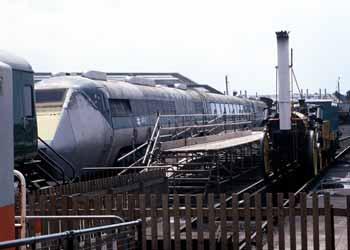 |
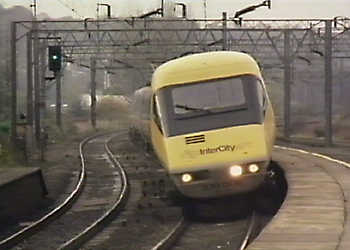 |
|
| The prototype gas-turbine APT seen on display at the National Railway Museum (NRM) in York next to a replica of Stephensons' "Rocket" which proved the viability of the steam engines and railways back in 1825.
The NRM has a website at http://www.nrm.org.uk/ |
An APT-P tilting train demonstrating its lean. | |
|
Operating just one return trip daily with the outward journey running at the crack of dawn on a bitterly cold, frosty, snowy morning the initial public service was marred by a series of unlucky failures which attracted such hysterical negative press attention that even with further trials in the summer of 1982 (when the APT-P trains had been quietly reintroduced into service, and ran regularly with the problems having been apparently corrected) ultimately the whole project was abandoned. The media simply did not care that all wheeled transports - both road and rail - were also suffering weather-related delays and problems on those few fateful wintry mornings..... by way of comparison, the media's reaction was far less hostile when extreme wintry weather in December 2009 resulted in five (5) TGV derived Eurostar trains breaking down in the Channel Tunnel with some passengers trapped (in the semi-dark) for many hours. Perhaps back in 1981 the media was doing the bidding of a government which was actively hostile to the railway system and wanted to contract the network - rather than see it thrive. One specific complaint levied by those journalists who were carried on the fateful first APT journey was that a side-effect of the tilting induced a feeling of 'queasiness', as in sea-sickness. Knowing the journalists' liking for alcoholic beverages some wags suggested that this was the cause of their feeling unwell, however in fact it turned out that perfectly compensating for lateral forces around curves could induce motion sickness, since the eyes could see turning but the body did not feel it - once this became apparent a solution was found by reducing the tilt by a few degrees so the curves could be felt. |
||
Perhaps if the passenger trials of the APT had been introduced into public service more quietly, and had not involved either services into London or any media invites, then there would have been a better chance of debugging the faults before they attracted such glaring media attention. And the trains would probably have been operating successfully today. Instead what should have been Britain's super train of the 1980's (and beyond) has now been reduced to being a museum curio. |
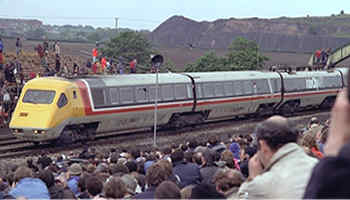 The ill-fated class 370 articulated tilting APT-P. As the main text details, the APT project floundered and was eventually killed off. Not seen in the picture is that it is being pushed by a diesel locomotive. |
|
|
The APT project as a whole took over 14 years to develop and involved the introduction of 1,000 new parts with the train using as much if not more aeronautical technology than railway technology. Although it was scrapped some of the technology was able to be ported to other trains, nevertheless its loss set the railways back years, and indeed from then on British trains operating in daily service on pre-existing classic lines have never reached the speeds they would have had the APT-S (Advanced Passenger Train - Squadron) been introduced. With Britain 'giving up' the Italians bought up (some of) the technology and made it work on their Pendolino trains. Now the technology has come back to Britain with two fleets of trains introduced in the early to mid 2000's. The first is a tilting version of the diesel 125mph Virgin Voyager train whilst the other is a variant of the Italian Pendolino tilting trains which are used on the prestigious London (Euston) - Birmingham - Manchester / Liverpool / Carlisle - Glasgow West Coast Main Line. The latter were originally designed to operate at 140mph (225km/h), but following delays and financial overruns in the upgrading of the physical infrastructure (ie: the tracks and signalling) to cope with such speeds it has been decided to restrict them to just 125mph (201km/h). Nowadays tilting trains (of various designs, using different tilt technologies) also operate in Switzerland, Germany, Norway, Sweden, Finland, Czech Republic, Canada, Australia, the USA plus other countries. Perhaps if we in Britain had of had more faith in the APT then successful operation on our domestic services would have lead to export sales for us too; Britain was the birthplace of railways, for many years our factories thrived on building trains for both home and export markets and it is perhaps unfortunate that the forward looking vision of the APT's creators for a fleet of tilting trains on the prestige West Coast Main Line is being realised 25+ years late by our buying technology developed overseas. |
||
 |
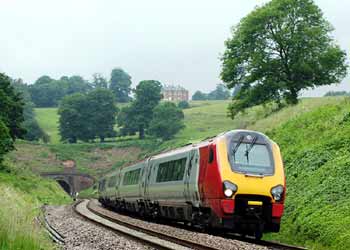 |
|
| One of the Italian class 390 Virgin Pendolino trains which now operate some of the services the APT was originally meant to provide. | A northbound class 221 Virgin Super Voyager tilting diesel train leaves Whiteball Tunnel to start its descent of Wellington Bank in Somerset.
Image & license: Geof Sheppard / Wikipedia encyclopædia. CC BY-SA 3.0 http://commons.wikimedia.org/wiki/File%3AWhiteball_tunnel_221115.jpg In summer 2009 half of the fleet of these trains was allocated by British Government officials to a train operator who did not need tilting trains, so the ability to tilt was de-activated and locked out of use. |
|
Tilting Trains OverseasSome sources suggests that one of the first successful tilting train designs was the Spanish Talgo. This was developed in the 1950's as a lightweight, fast train, and was (initially) mostly used within the Iberian peninsula. However it is the Italians who could be said to have had the greatest success with tilting trains, not just within their own borders but with derivatives of their Pendolino now operating in Spain, Portugal, Slovenia, Finland, the Czech Republic, Slovenia, the United Kingdom, Switzerland, China and the Russian Federation. Spain also uses trains which are physically similar but were built without the tilting system. These are used on high-speed medium distance services and retain the 250km/h (155mph) top speed capability. The word Pendolino comes from the Italian word pendolo (pendulum) with the -ino diminutive suffix added at the end. Perhaps therefore it could be translated as 'little pendulum'. It is also a trademarked brand name that originally belonged to Fiat Ferroviaria, a former division of FIAT of Italy that since its 2002 acquisition now belongs to the French firm Alstom. Although the Italian tilting train trials had already seen the construction of several experimental trains (some of which featured fixed carriages and tilting seats!) it was in 1969 that the first working design was built and named Pendolino. Further primarily experimental trains followed, with examples being used in both Italy and Spain. In 1982 the Italians purchased the patents for the tilting bogie used in the ill-fated British APT project, and together with other improvements this led to the introduction of the first Pendolino trains to enter regular service. These trains proved the technology as being viable, travelling between Rome and Milan in under four hours, at speeds up to 250km/h (155mph). Since then several families of Pendolino train have been built - for both home and export markets. In Italy Pendolino trains are used on several services. Typically the tilting mechanism becomes active when negotiating curved track at speeds of over 70km/h (43mph). This helps reduce the G-forces as the train travels through the curves. Typically the train's body will by up to 8°. Germany has several fleets of regional and express tilting (diesel) multiple unit type trains which use Pendolino tilting technology. Known as the RegioSwinger the 160km/h (100mph) regional trains are diesel operated, have also been sold to Croatia too. Also included in the types of train for which the Italians supplied the bogies and the tilting technology so could be called Pendolino's (but are not) are the tilting ICE T and ICE TD trains. The ICE T (electric) train has a maximum speed of 230km/h (143mph) whilst the ICE TD (diesel) trains have a maximum speed of 200km/h (124mph). Germany has had some problems with its tilting trains - both high and normal speed versions - and for a while the tilting function on these trains was deactivated, leading to lengthened journey times. ICE TD are expected to be withdrawn in 2016. This is because DB does not want to pay for their next scheduled heavy overhauls during which all components are checked and replaced if needed. Whilst the Danish State Railways (DSB - Danske Statsbaner) offered to buy them it also did not want to pay for both the trains and the overhaul. Another issue is that these trains have high maintenance costs and high diesel consumption. It may be noted that whilst capable of high speeds tilting trains tend to have lower top speeds than the fastest trains seen in the section above. |
||
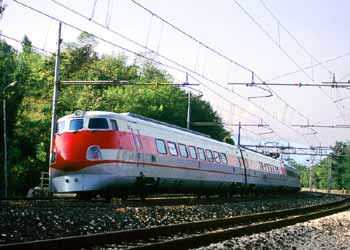 |
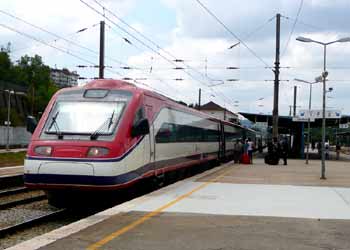 |
|
| Introduced in 1989 the ETR 450 (ElettroTrenoRapido 450) was the first series Italian tilting train (Pendolino). Their maximum speed is 280km/h (174mph), although when in passenger service they were restricted
to 250km/h (155mph). Seen near Bologna, in 1990.
Image & license: Sandro Baldi / Wikipedia encyclopædia. Public Domain. http://commons.wikimedia.org/wiki/File%3AETR_450.jpg. |
The Portuguese Pendolino trains are known as Alfa Pendular. Their top speed is 220km/h (137mph). This image shows one of these trains at Coimbra B station, from where people going to the city centre can catch a local or regional shuttle train to Coimbra A station which is in the city centre |
|
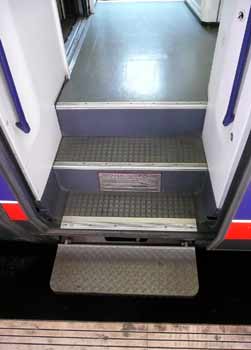 |
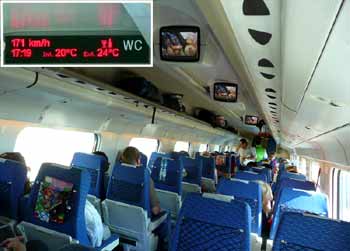 |
|
| The entrance to an Alfa Pendular train. As with many European trains the lowest step extends from the train as part of the door opening process and helps fill the gap between the train and the platform. |
Inside an Alfa Pendular tilting train - photographed whilst tilting! The inset shows the red LED passenger information displays, these are located at each end of the carriage. | |
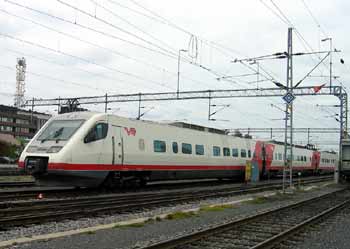 |
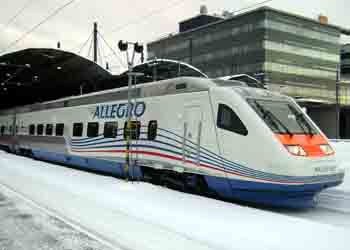 |
|
| The highest speed achieved by the Finnish Sm3 was 242km/h (150mph) although when in normal passenger service they are restricted to 220km/h (137mph). Seen near Oulu station, Finland.
Image & license: SeppVei / Wikipedia encyclopædia. Public Domain. http://commons.wikimedia.org/wiki/File%3ATrain_in_Oulu.JPG. |
Karelian Trains Class Sm6 Pendolino on the high speed Allegro (quick tempo which suggests high speed!) service between Helsinki, Finland, and St. Petersburg, Russia which saw journey
times between the two cities reduce from 5½ hours to 3 hours 36 minutes. These trains are based on the more technically advanced ETR600 / ETR610 New Pendolino.
Image & license: Otto Karikoski / Wikipedia encyclopædia. CC BY-SA 3.0 http://commons.wikimedia.org/wiki/File:Sm6_Allegro_7053_Helsinki.JPG. |
|
Finland has had many reliability issues with its SM3 trains, mostly these were caused by technical problems with the tilting system and the couplers. The coupling problems became serious when there was need to join two train units from different remote destinations at intermediate stations and then run them as one double-length train. Sometimes it became necessary to resort to running the two units separately, which required extra train staff and used an extra train path on an already heavily used section, a process which often then delayed other trains. Problems also extended to separating two coupled units, and were eventually diagnosed as having been caused by moisture in the couplers. In the end the timetable was recast in a way which did not need multiple units to couple together. To try and solve all these problems the fleet is being refurbished (between 2012 and 2014), with the works including fitting new couplers, installing heaters in the trains' undercarriages to prevent the formation of ice during the winter and a reduction the maximum angle of tilt. The Karelian Trains Class Sm6 Pendolino trains have been designed to operate on both the Finnish 25,000v AC 50 Hz and the Russian 3,000v DC electric power supply systems. In addition, their wheelsets are built to permit 200km/h (120mph) operation on both the Finnish 1,524mm (5ft 0in) and the nominally slightly narrower Russian 1,520mm (4ft 11.8in) gauge tracks. The passenger doors are equipped with retractable steps to facilitate easy boarding from station platforms which in Finland are 550mm (22in) high and in Russia are 1,100mm (43 in) high. The trains are also compatible with both nation's signalling and other technical systems, which differ substantially. Customs and border formalities are normally carried out during the journey. Passenger facilities include a children's play area, space for passengers using a wheelchair, seats for pet-owners, a conference compartment, currency exchange and tax free refund services, a restaurant and stand-up bar area - the latter are closed whilst the train is passing through the customs surveillance zone. |
||
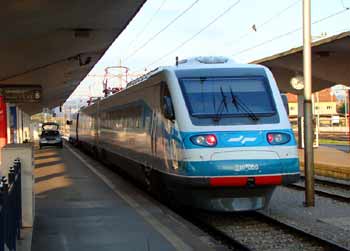 |
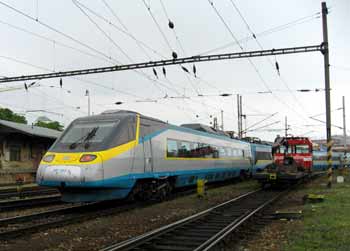 |
|
| SŽ 310 series Pendolino EMU in Ljubljana, Slovenia.
Image & license: Orlovic / Wikipedia encyclopædia. CC BY-SA 3.0 http://commons.wikimedia.org/wiki/ File%3AS%C5%BD_310_series_EMU_(04).JPG. |
ČD Class 680 Pendolino at Brně Czech Republic.
Image & license: Dezidor / Wikipedia encyclopædia. CC BY-SA 3.0 http://commons.wikimedia.org/wiki/File%3APendolino.jpg. |
|
The Swiss have also had cause to be disappointed with their ETR 470 Pendolino tilting trains. Operated by Cisalpino, a company formed in 1993 to operate cross-border trains between Italy and Switzerland and then on to Germany, the ETR 470 trains were plagued with such severe reliability issues that for a while its Swiss and Italian owners - train operators (SBB and Trenitalia) - would keep reserve trains available at a moments notice at each end of the Milan - Zürich route. In addition, because of the reliability issues these trains were withdrawn from the Zürich - Stuttgart (Germany) route and replaced with German ICE-T tilting trains. |

Cisalpino ETR 470 Cisalpino tilting train passing through the Swiss lakeside town of Flüelen on an international working from Stuttgart (Germany) to Milan (Italy) via Zürich (Switzerland). |
|
New PendolinoIn an attempt to improve the situation Cisalpino tried to introduce the New Pendolino ETR 610 trains which it called Cisalpino Due (Cisalpino Two) but these arrived late and then during testing it was found that they were so heavy that there was no point in them using the Gotthard mountain pass route - for which they had been purchased. The issue is that due to forces on the track the weight of the train influences the permitted cornering speed and it was found that the new ETR 610 Pendolino trains would have to run so slowly that traditional trains without tilting technologies would be just as fast. By then it was too late and the Cisalpino brand had such a bad reputation for reliability that in 2009 the joint company was closed and the ETR 470 trains split between Italy and Switzerland. Later the Swiss withdrew their ETR 470 trains and the service was rebranded EuroCity, a name that Cisalpino was already using on other cross-border services which used conventional locomotive hailed trains. Pending arrival of a new type of train - the Stadler EC250, which is yet to be introduced - the Swiss replaced their ETR 470 trains with ICN and RABe 503 (New Pendolino) trains. But the Italians still use their ETR 470 trains on this service. The New Pendolino is a further development of the earlier Pendolino train types. To improve reliability they feature some important technical improvements, including a level of redundancy of components and equipment. This family of high-speed tilting trains is being built by Alstom Ferroviaria for Trenitalia (Italy), SBB / CFF / FFS (Switzerland), Renfe (Spain), and PKP (Poland), who know their variants as ETR 600 / 610, RABe 503, Avant S-114 and ED250 respectively. The Italian ETR 600 trains are dual voltage, 3kV DC / 25kV AC whilst the ETR 610 are tri-voltage, 3kV DC / 25kV AC / 15kV (16.7 Hz) AC, the latter being needed for use in Switzerland and Germany. They have a maximum speed of 250 km/h (155 mph) and operate through the Lötschberg Base Tunnel. Although the brand name Pendolino is synonymous with tilting train, some of the variants listed here have not been fitted with tilting equipment. |
||
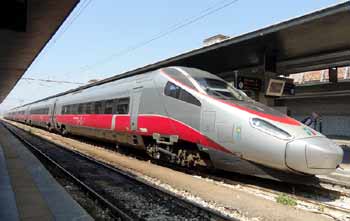 |
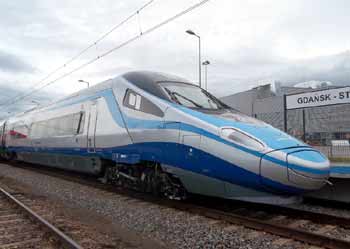 |
|
| ETR600 Frecciargento train at Venice Santa Lucia Station.
Image & license: MitKawa / Wikipedia encyclopædia. CC BY 3.0 https://commons.wikimedia.org/wiki/File:Trenitalia_ETR600_Frecciargento.JPG. |
Polish ED250 Pendolino train at the 2013 Trako exhibition in Gdansk.
Image & license: MitKawa / Wikipedia encyclopædia. CC BY 3.0 commons.wikimedia.org/wiki/File:ED250-001_Pendolino_prz%C3%B3d(1)_Trako13.jpg. |
|
The intent in Poland is that their Pendolino trains will eventually travel at 250km/h. The process of achieving certification for use at this speed included a test train reaching 275km/h. The speed test was performed on the "Central Railway Mainline" between Warsaw and Krakow and in fact the train reached 293km/h, in the process setting a new speed record for a train in Poland. At present the trains are only used in Poland but in future it is hoped for there to be through services into Germany, Austria and the Czech Republic. The trains have been designed for temperatures between -25°C and +45°C. In addition to the usual expected passenger facilities there are two CCTV cameras per carriage and each train has nine bicycle racks. |
||
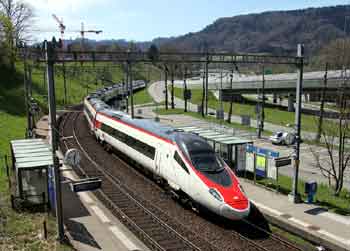 |
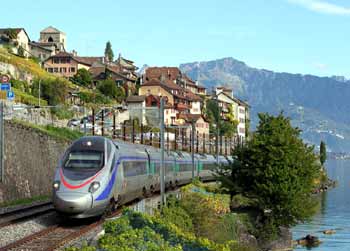 |
|
| Swiss Railways (SBB CFF FFS) RABe 503 013 passing Brunau station in suburban Zürich while en route from Milan to Zürich.
Image & license: NAC / Wikipedia encyclopædia. CC BY-SA 4.0 https://commons.wikimedia.org/wiki/ File:32_FFS_RABe_503_013_Zuerich_Brunau_120415_EC30012.jpg. |
Italian Railways ETR 610 005 travelling from Milan to Geneva near to St-Saphorin which is alongside Lake Geneva.
Image & license: NAC / Wikipedia encyclopædia. CC BY-SA 3.0 https://commons.wikimedia.org/wiki/File:ETR610_005_St-Saphorin_06-10-2010_EC34.jpg. |
|
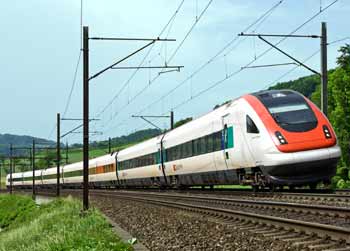 |
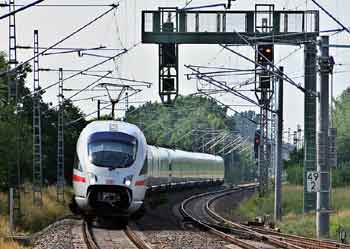 |
|
| The Swiss RABDe 500 ICN (Intercity-Neigezug - Intercity Tilting Train) has a maximum speed of 200km/h (124mph). Seen here at Hauenstein. Image & license: Sese Ingolstadt / Wikipedia encyclopædia. CC BY-SA 3.0 http://www.bahnbilder.ch/picture/229. |
A German ICE-T passing through Paulinenaue station on the Berlin-Hamburg high-speed railway line. On these trains the driver's cab has a glass wall so that some passengers sitting in the front carriage can enjoy watching where the train is going out the front window. Image & license: Sese Ingolstadt / Wikipedia encyclopædia. CC BY-SA 3.0 http://commons.wikimedia.org/wiki/File%3AICE-T_Paulinenaue.jpg. |
|
In addition to their ICE-T the Germans also have other types of tilting train which are intended for slower services. Some of these have also had severe problems every bit as bad - if not worse - than the the ETR 470 trains. Sweden has also developed its own high(er) speed trains, rather than buying from other nations. Because there is not enough traffic to justify building brand new high speed lines so the Swedish opted to use tilting trains on 'classic' lines which are subject to many curves. Known as the X2 their normal top speed is 200km/h (124mph), although 276km/h (172mph)has been achieved in a test. Technically these trains are described as being of the 'multiple unit' variety, however in reality this is not so, although it has been designed to look like a passenger carriage the traction equipment is located in an electric locomotive at one end of the train. This also means that the trains operate on the push-pull principle, with for many journeys the passenger carriages being propelled from the back. but does not actually carry any passengers. Variants of the X2 have been sold to Norway too. For Norway they have been reconfigured to act as true distributed power multiple-unit trains and have also been redesigned visually. The Norwegians have several fleets of these trains, both of which have a maximum speed of 210km/h (130mph) which they only reach when travelling on a new stretch of 'medium speed' railway built to serve a new airport 50km (30miles) from Oslo, the capital city. Away from this line they are restricted to 160km/h (100mph) although the twisting nature of much of Norway's rail network means that they are often unable to even attain this speed. Although visually similar only the trains which operate longer distance services throughout much of Norway have the ability to tilt. The trains on the airport service do not need this. |
||
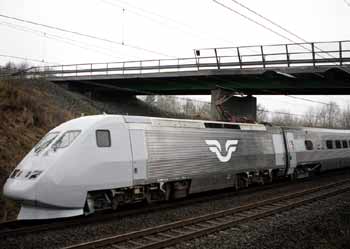 |
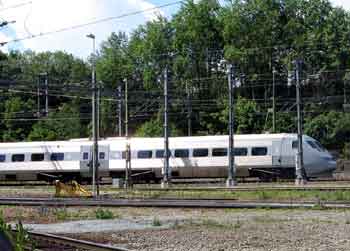 |
|
| The electric locomotive end of a Swedish X2 train on a X2000 service.
Image: SJ AB official press service. Free use, any purpose, if attributed. http://commons.wikimedia.org/wiki/File%3AX2000_exteri %C3%B6r_vid_k%C3%B6rning_i_Tormestorp_SJ_AB.jpg. |
The passenger carriage end of a Swedish X2 train on a X2000 service.
Image & license: ArséniureDeGallium / Wikipedia encyclopædia. CC BY-SA 2.5 commons.wikimedia.org/wiki/File%3ATrain_-_Stockholm0358b.jpg. |
|
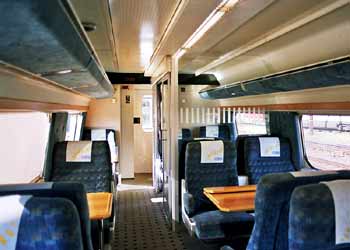 |
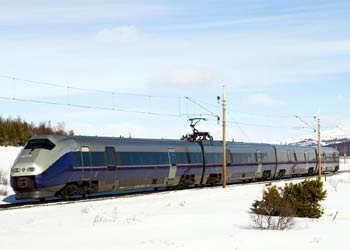 |
|
| Inside an X2 first class carriage, showing an option for fully enclosed compartments which would allay some people's concerns about personal safety - as can be seen here the glass walls retain the visual safety of an open carriage whilst still providing a more private ambiance. | Norges Statsbaner (NSB) Class 73 on Dovrebanen between Dombås and Fokstua.
Image & license: David Gubler Gnu Free Document License http://www.bahnbilder.ch/picture/3386. |
|
Examples from Beyond EuropeAs with the Shinkensan trains seen above, tilting trains abound in Japan. Below are two of the many possible examples. They do seem to be leaning somewhat precariously - at first glance its a wonder that they are not going to topple right over! |
||
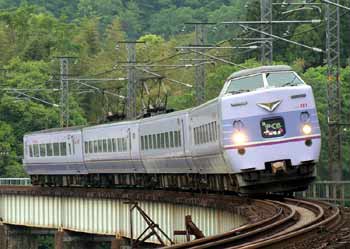 |
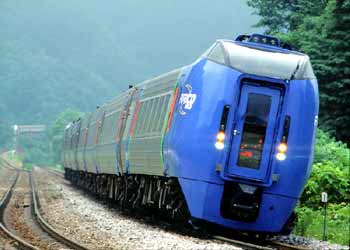 |
|
| JR West Yakumo381 hikantuu train.
Image & license: Mitsuki-2368 / Wikipedia encyclopædia. CC BY-SA 3.0 http://commons.wikimedia.org/wiki/File%3AYakumo381_hikantuu.jpg. |
JR Hokkaido DC283 tilting train, which can tilt up to 8° (5° in normal operation). Image & license: Penpen / Ja Wikipedia CC BY-SA 3.0 http://commons.wikimedia.org/wiki/File%3ADC283_hokuto_001.jpg. |
|
Tilting trains are used on a few longer distance routes in Queensland, Australia, linking the state capital Brisbane with coastal communities elsewhere in Queensland. There are only a few trains, some diesel, some electric and because of the low population density the trains travel less frequently than would be acceptable in some areas. Furthermore, although deemed 'fast' the speeds are relative, as they have been recorded at 210km/h (130 mph) the normal maximum service speed is 160km/h (100 mph). It should be noted however that these are narrow gauge trains and use tracks which are just 1,067mm (3ft 6in) apart. Canada's fastest train is the former CN TurboTrain, which was introduced in 1968 and in April 1976 reached 140.6mph (226.2km/h). The TurboTrain was used on 'classic' lines linking the cities of Québec, Montréal, Ottawa and Toronto. To make them lighter these trains were largely built out of aluminium and used gas-turbine engines. In addition to being tilting trains they also featured guided axles which enabled the train to take curves at speeds 40% greater than conventional trains. The Canadian Turbotrains were withdrawn in 1984. Between 1968 and 1976 the TurboTrains was also used in the USA, but whilst they were less successful commercially on 20th December 1967 a three car TurboTrain achieved the global speed record for gas turbine-powered rail vehicles with 170.8mph (275km/h) on the DOT's high speed test track on Penn Central's main-line between Trenton and New Brunswick, New Jersey. This is still the North American speed record for the fastest production train. In 1981 Canada introduced the tilting LRC train. Instead of using articulated trailers these trains are of conventional design with separable carriages that can be intermingled with non-tilt carriages. LRC is a bilingual acronym for Light, Rapid, Comfortable / Lèger, Rapide, et Confortable. LRC trains were designed to operate at up to 125mph (201km/h) on the Québec City - Windsor Corridor, and many sections of this Corridor were signed for higher speeds when the LRC's tilting system is activated. However, during development the locomotive weights increased to the point that service at this speed would produce too much wear on the rails, so whilst LRCs have reached speeds as high as 130mph (208km/h) on test runs, track wear concerns and signalling issues limit this to 100mph (160km/h) or less. The LRC family included both locomotives and passenger carriages designed to work together or separately. The latter option represents the current situation, as whilst the last LRC diesel engine was withdrawn from service in 2001 the passenger carriages continue to form the backbone of VIA Rail's services - albeit often with the tilting mechanism disabled. Updated versions of the LRC carriages and their tilt systems are now used on the Amtrak Acela Express electric high-speed trains seen below and the British Class 221 Super Voyager trains seen further up this page. |
||
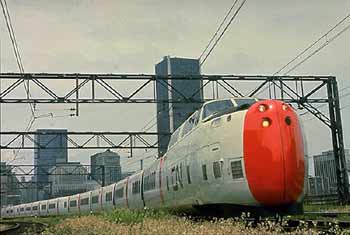 |
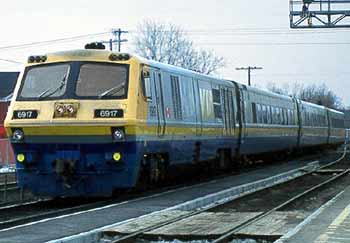 |
|
| Canadian National (CN) TurboTrain near to Montréal.
Image: Wikipedia encyclopædia, subsequently deleted. http://en.wikipedia.org/wiki/TurboTrain. |
VIA Rail Canada LRC #6917 comes to a stop at Brockville, Ontario.
Image & license: Randy Plunkett / Wikipedia encyclopædia. CC BY-SA 3.0 http://en.wikipedia.org/wiki/LRC_(train) |
|
The links above lead to Wikipedia pages which contain further information about these trains.
The USA's fastest trains are the Acela trains which operate on the North East Corridor that links Boston, Mass. with Washington, DC via a heavily populated string of conurbations including Baltimore, Wilmington, Philadelphia, New York City, the Connecticut coast and Providence. Although capable of 165mph (266km/h), the United States Federal Railroad Administration (FRA) does not permit speeds above 150mph (241km/h) on tracks that are shared with freight and slower passenger trains. Even so, achieving these speeds is still very commendable (and betters the situation here in Britain) considering that the Acela travels on pre-existing "classic" infrastructure. The slowest sections of line are between New Haven, Connecticut and New Rochelle, New York where speeds rarely exceed 60mph (97km/h) and even where they do tiling is prohibited. Unfortunately this section of track includes a parallel road which has a higher speed limit, so road users are given the impression that trains are slower than cars. Acela trainsets tilt above 60mph (97 km/h) on most of the system, but some segments of track along the Northeast Corridor are too close together for the carriages to safely tilt while maintaining FRA minimum space between trains on parallel tracks. In addition, the Metro-North Railroad does not allow tilting on its tracks. While the system was originally designed for a 6.8° tilt, the carriages were redesigned four inches (10cm) wider to accommodate wider seats and aisles that reduced allowable tilt to a more modest 4.2° to fit within the clearance constraints of the existing tracks. Speeds higher than 135mph (217km/h) also requires constant-tension catenary, which is only used on the more modern catenary system north of New York City. All in all the line is so curvaceous that trains travelling between New York and Boston travel the equivalent of over 11 full circles! Although the design of the trains, with identical 6,000 horsepower (4,470 kW) power cars at each end which operate on a voltage of 11,000 volts AC, and either 25 or 60 Hz frequency, resemble France's TGV, only certain components are directly derived from the TGV. The tilting passenger carriages are based upon Bombardier's earlier LRC trains used on Canada's Via Rail rather than the TGV's non-tilting articulated trailers. The need to meet the FRA's rail crash standards, which includes a requirement to be able to collide with a freight train at speed without collapsing, means that the entire train has been built with massive amounts of extra steel and therefore is much heavier than high speed trains in other countries which use modern signalling and computer controls to ensure crash prevention. Elsewhere in North America very high speed trains have been investigated in Florida and for use along the west coast to link the cities of Vancouver (British Columbia, Canada) with San Diego at the Mexican border, travelling via Seattle, Portland, San Francisco, Los Angeles, etc., In addition a French TGV has been proposed for a Canadian service on the Québec - Montréal - Ottawa - Toronto route. In some cases these trains would use specially built dedicated high speed infrastructure too. 'We shall see', as the saying goes. |
||
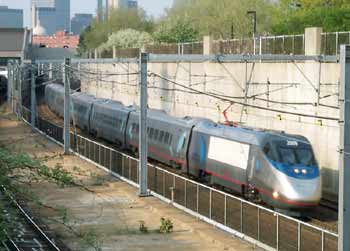 |
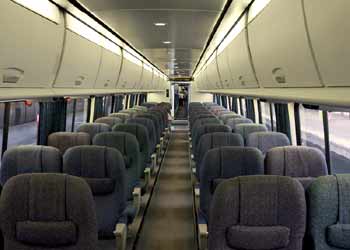 |
|
| Acela Express train 2175 drifting through a curve south of Back Bay, Boston. Image courtesy of Clem Tillier. |
With compartmentalised luggage racks that feature close-able covers this Acela Express business class carriage has an ambiance not unlike the inside of an aircraft. Image & license: Bruce Tuten / Wikipedia encyclopædia. CC BY 2.0 http://commons.wikimedia.org/wiki/File:Business_class_on_the_Alcea.jpg. |
|
Magnetic Levitation (Maglev) TrainsAs technology advances another type of very high speed train has been developed which replaces the traditional steel wheel on steel rails aspect of the railway with powerful electro-magnetics so that the trains float above the track on a cushion of air. This reduces friction, gives a very smooth quality of ride and makes such vehicles relatively quiet. Magnetics are also used for propulsion and braking. Known as the Maglev (ie: 'magnetic levitation train') the advantage of this technology over conventional steel wheel technologies is that there are massive savings in maintenance and there is the possibility of full 24-hour service - conventional railway tracks must have every stretch inspected every 72 hours (or even more frequently) and as this involves railway staff walking along the tracks it requires the lines to be closed to moving trains. This is usually done at night - and partly explains why conventional railways cannot offer 24 hours / all-night services. Maglev does not have this issue, as the system should only need periodic maintenance shutdowns - although most travellers and safety officials would probably feel happier if (at a minimum) this was done on a weekly basis. The first commercial maglev line opened on the 29th December 2003, and provides an ultra high speed service linking Pudong International Airport with Shanghai, China. Despite the distance being over 30km the journey takes less than eight minutes. Bearing in mind that this journey time includes acceleration and braking, this is very fast! The "Transrapid" system uses German technology and is capable of cruising at 300mph+, although on such a short line that speed is not reached. For more information visit http://www.transrapid.de or http://www.transrapid-usa.com. In February 2005 the UK Ultraspeed consortia put forward proposals for a British Maglev network linking 75% of the British population along the London - Birmingham - Liverpool - Manchester - West Yorkshire (Leeds) - Teeside - Tyneside (Newcastle-Upon-Tyne) - Edinburgh - Glasgow corridor. More information can be found at their website http://www.500kmh.com |
||
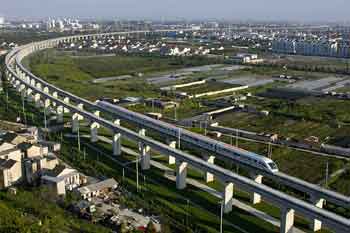 |
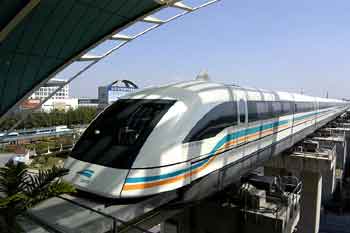 |
|
The first commercial application of high-speed maglev "anywhere" globally is the 30km, double-track line which connects Shanghai to Pudong International Airport. With a peak operating
speed of 430km/h (267mph), each one-way trip has a duration of less than eight minutes.
Both images sourced from manufacturer's promotional material. Even faster???It is often suggested on some of the 'alternative' news & information websites that deep underground there is a very high speed inter-continental Maglev system which travels in vacuum tunnels and (possibly / probably) uses advanced magnetics as a propulsion system. Information regarding the system's top speed varies with some sources suggesting that it travels at 4000mph (6440km/h) and others at double or even triple this speed. Reports suggest that passengers experience mild 'g' forces during acceleration (and deceleration) with people who are susceptible to travel sickness sometimes feeling a little queasy. At the present time no evidence can be offered as to the veracity of this information, however even so the possibility that this really does exist is not totally disbelieved. One reason for this is because there are too many other equally 'wild' news items where there is only circumstantial evidence - such as totally independent people saying the same things, etc - which when looked at together suggests that many secrets about what is happening below the ground / above our skies are being withheld from the massed public. |
||
Direct links to other Passenger Train Variations pages.
 |
|||||||||||||||||||||||||||||||||||||||||||||||||||||
 |
|||||||||||||||||||||||||||||||||||||||||||||||||||||
 |
|||||||||||||||||||||||||||||||||||||||||||||||||||||
 |
|||||||||||||||||||||||||||||||||||||||||||||||||||||
 |
|||||||||||||||||||||||||||||||||||||||||||||||||||||